
Welcome to our blog.
Sorry, no results were found, search again?

Welcome to our blog.
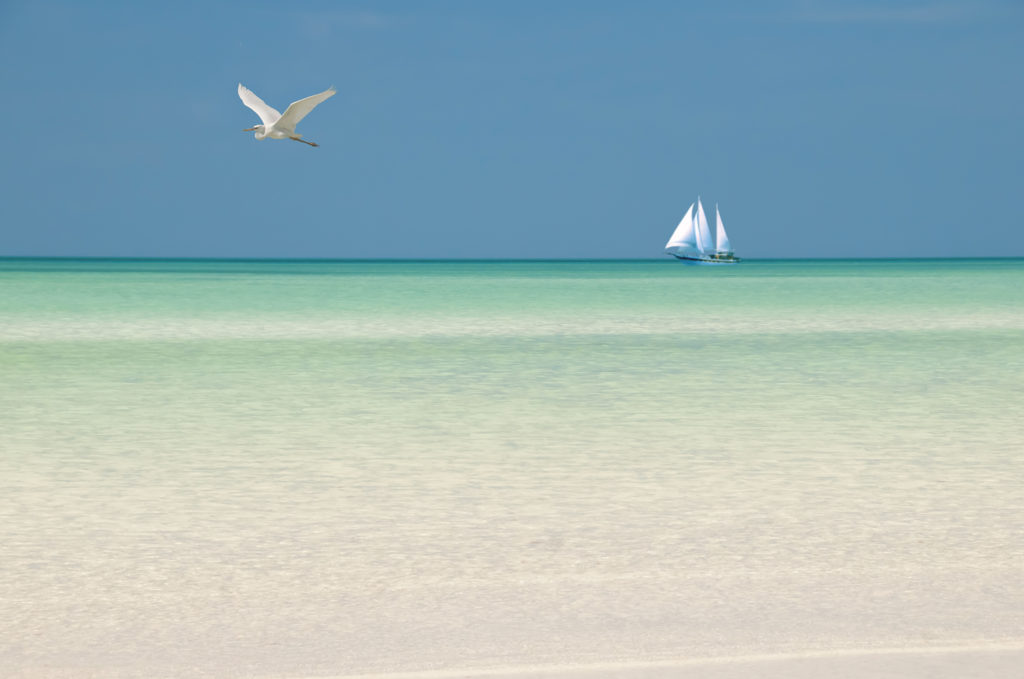
When you think of the Yucatan or even the Riviera Maya in Mexico, Cancun might first jump to your mind, however there is so much more to the Yucatan peninsula. From Mayan ruins, to lush jungles, to hidden cenotes, gorgeous beaches, to culture and authentic food, this region of Mexico has it all. We have created a 10 Day epic Yucatan, Mexico road trip to include some of the best highlights across this unique area of Mexico, many of which are lesser known or off-the-beaten-path!
Instead of sticking to all-inclusive, touristy resorts of Cancun and other places along the Riviera Maya, this itinerary will take you into the real heart of Mexico, where you will fall in love with the natural beauty, rich culture and people that make the Yucatan special. Trust us, this will be a trip you won’t forget!
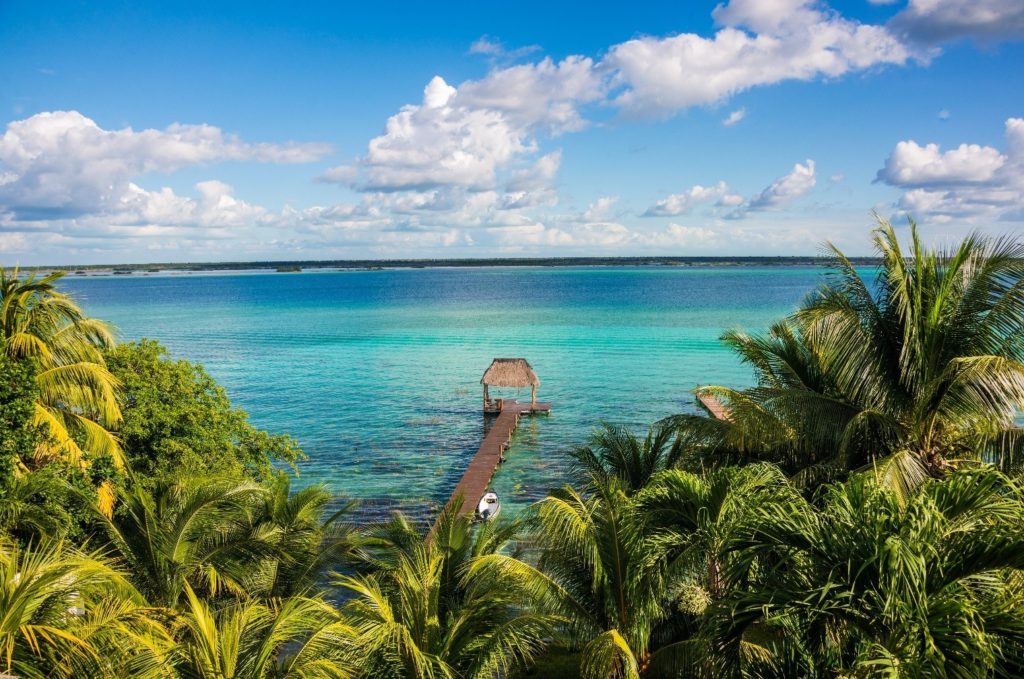
Since Cancun is the major international airport on the Yucatan, this is typically where you fly in/out of. Luckily you can often find cheap flights (especially from the States) on sites like Sky Scanner or Momondo, which is what we use to get the best deals.
Once you land and rent a car (we choose Booking.com), it’s a 2 hour drive south to Tulum where you will spend the next couple of days. If you are looking for more luxe accommodations (and Tulum would be the place to splurge), places like La Zebra Boutique Hotel or even Hotel Panacea are good choices with families, both situated on the beach.
For lower to mid-range hotels, our top picks would be Hotel Parasio (which lies in front of one of the prettiest beaches in Tulum), or for an apartment with fully equipped kitchen and other amenities, Casa KanKin.
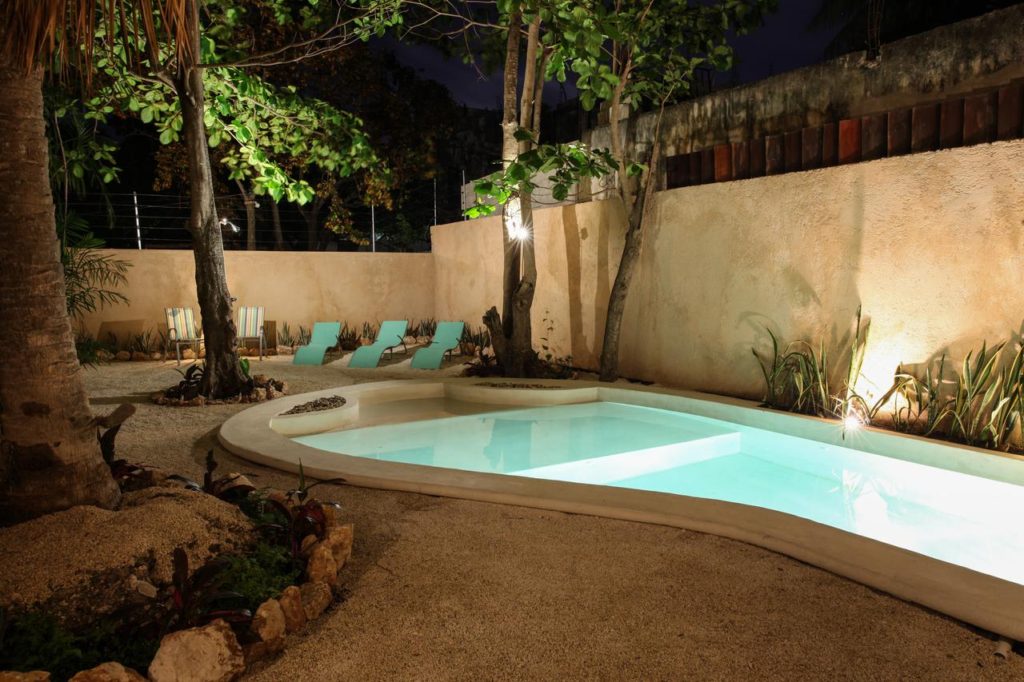
Depending on what time of day you arrive, use this day to just relax at the hotel or go to the beach in Tulum (Playa Parasio is a fave of ours).
A visit to the the famous Mayan ruins of Tulum which were built thousands of years ago on a cliff overlooking the turquoise Caribbean Sea are a MUST. Our biggest tip is to go EARLY. This is for two reasons: one, it is very hot and humid in the middle of the day, which make it a lot less fun walking around (especially with kids!) and two, you will have a lot less people to avoid.
How early do we recommend? Well, at the very latest, we would recommend arriving right before it opens at 8AM, but want to know a little insider tip? If you want to visit the ruins prior to opening (such as for sunrise), you can! All you do is pay a little extra (admission is $3-4 USD) and basically have the entire place to yourself, PLUS escape the heat. Sounds like a win-win. We did this and trust me, it’s 100% worth it.
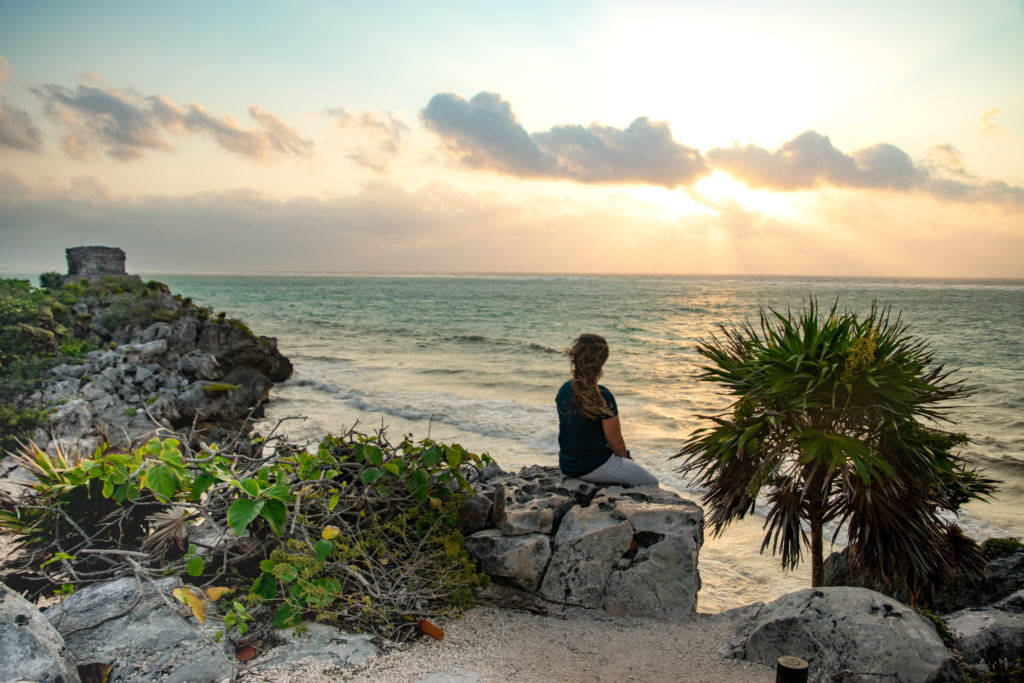
You really only need a couple hours at the ruins, so if you get here early enough, you literally have the rest of the day to hit the beach. Speaking of beaches, our favorites in and around Tulum are Secret Beach and Playa Parasio. The beach right below the ruins is also beautiful. Make sure to check out our other top beach picks near Tulum.
You can also hire a boat for cheap to take you out to the reef (which isn’t too far from the beaches) to snorkel if you choose.
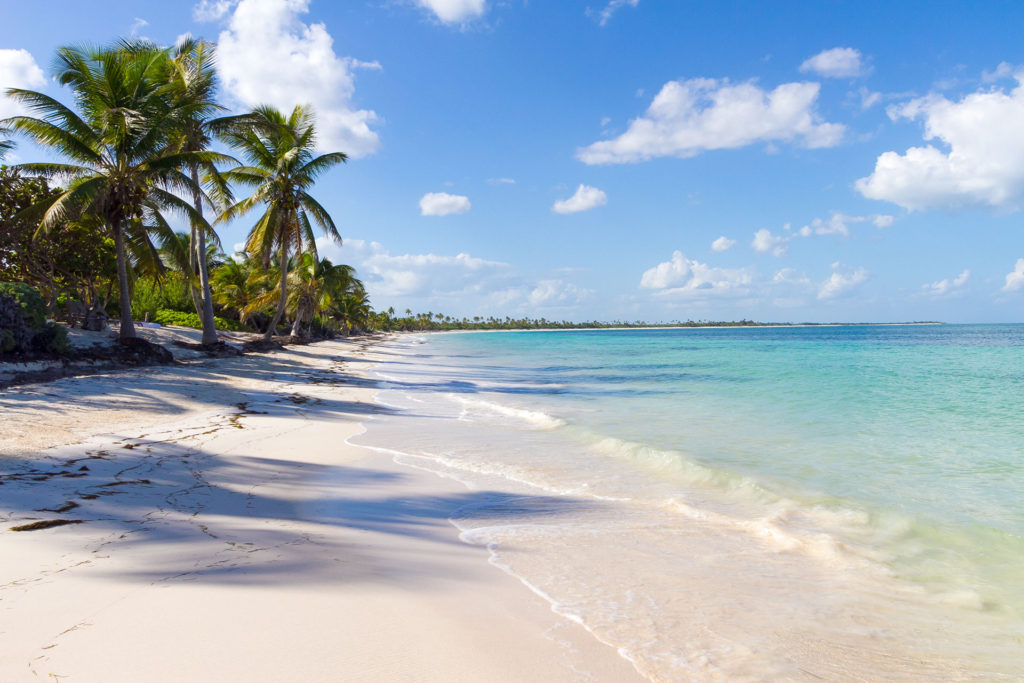
Sian Ka’an Biosphere is a lesser known gem and worth spending a day or part of a day at. Located just south of Tulum, Sian Ka’an bustles with serene lagoons, mangrove wetlands, cenotes, pristine beaches and tons of wildlife. We did a kayak tour with Yucatan Outdoors and it was such a treat to enjoy the lagoon all to ourselves while watching the sun set.
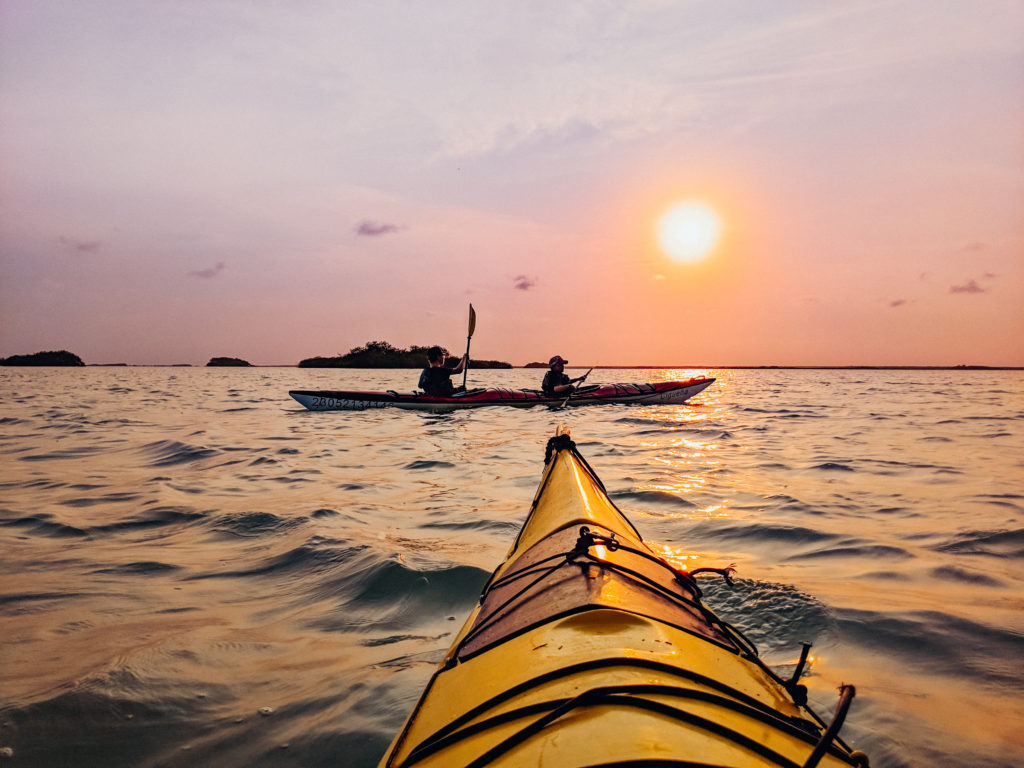
If you have time or would prefer not to kayak at Sian Ka’an, we would definitely recommend hitting a few cenotes near Tulum since some of the best in the entire Yucatan are located minutes away from the town center. See our top 18 cenotes for kids near Tulum for all the best ones!
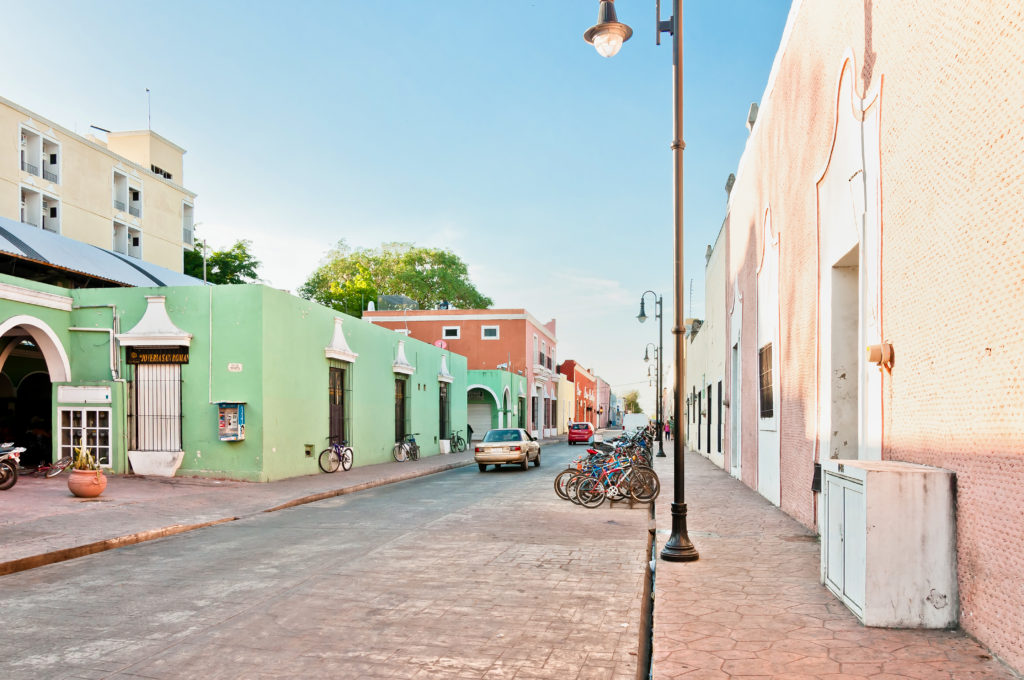
After a few fun-filled days in Tulum, head west (about a 90 min drive) toward the heart of the Yucatan peninsula, Valladolid. This colonial town is very charming. In fact, we were so blown away by how picturesque it is! It reminded us of Antigua, Guatemala with the colorful buildings, beautiful architecture, quaint cobblestone streets, central park and historic old churches. A great place to stay in town is Casa Valladolid Boutique Hotel. We loved how convenient it was to everything and also super affordable ($25/night)!
We would suggest spending a day in Valladolid wandering the streets, tasting all the food (we loved getting churros from the street vendors in the main plaza), and even visiting some churches. The main church not to be missed is located in the central park, right in the center of town, Iglesia San Servacio. You can also do a walking or bike tour if you want to learn more about the culture and history of Valladolid. Many of these tours also include cenotes too.
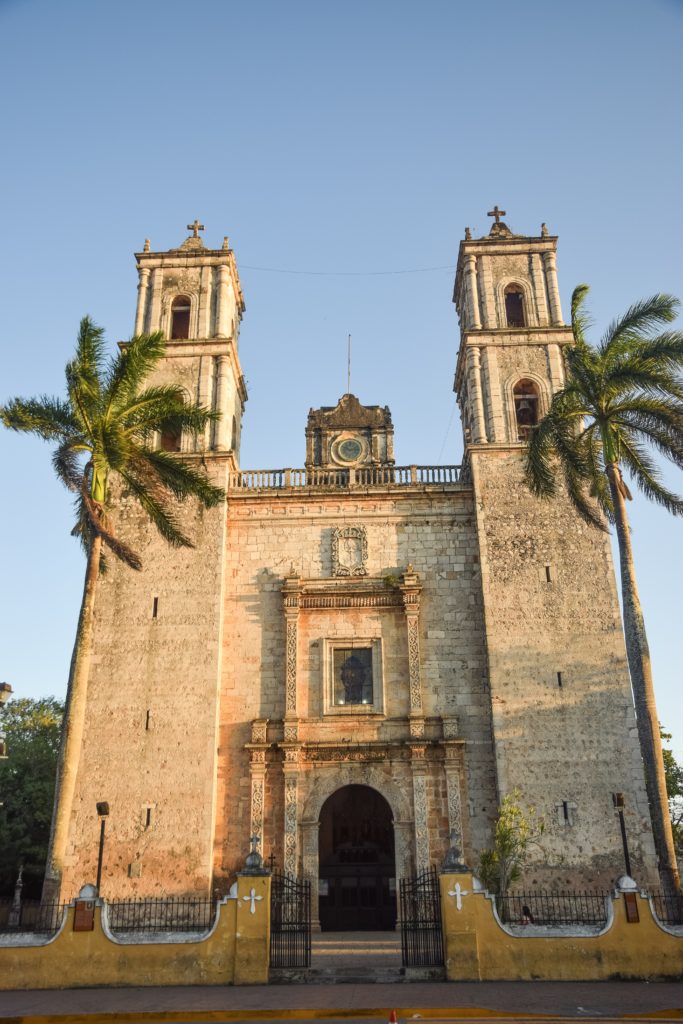
If you are really into churches, you might want to pay a visit to the church in the small town of Uayma, about 15 minutes from Valladolid. This church is incredibly unique and definitely worth the short trip! It’s hard to miss too!
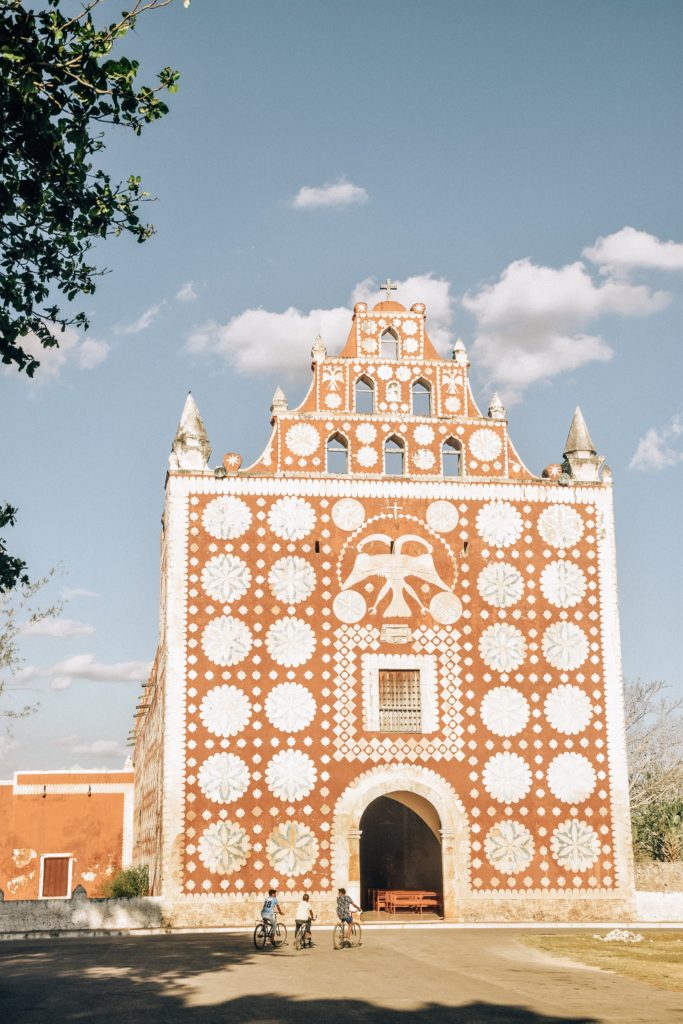
There is also a great cenote right in the middle of town called Cenote Zaci. This is the perfect swimming hole to cool off after a long day walking around Valladolid. It’s beautiful with spots for cliff jumping at various heights and plenty of shade too. The best way to end a hot day!
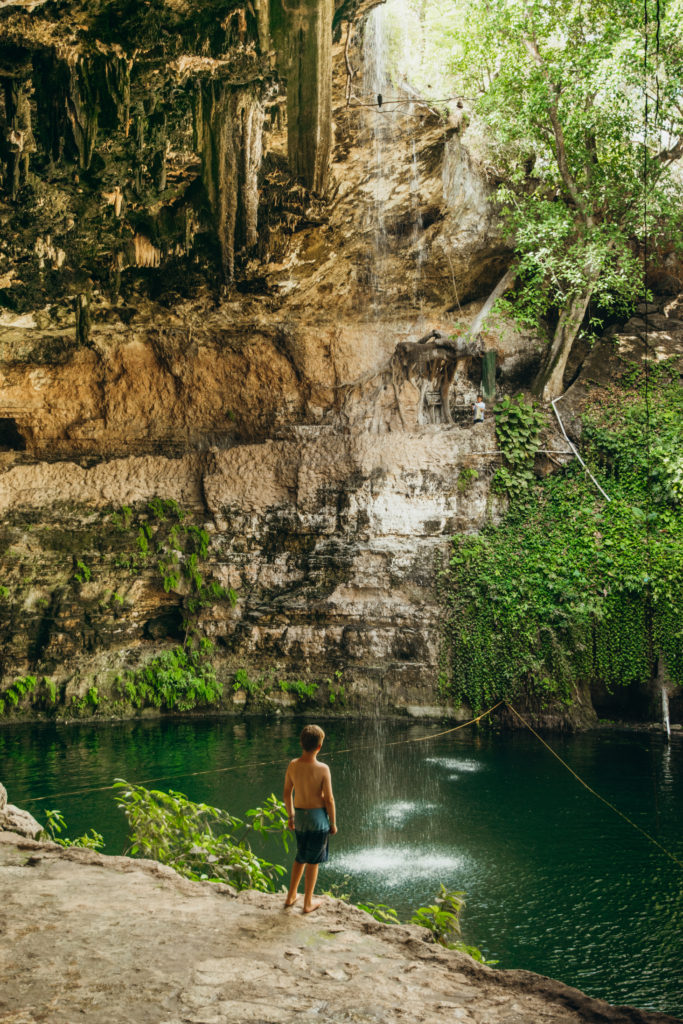
You don’t come to Valladolid without seeing probably the best cenotes in all of the Yucatan. There are several that are note-worthy, however if you only have time to visit 2 or 3, we would suggest Cenote San Lorenzo-Oxman (go first thing in the morning when they open), Cenote Suytun (middle of the day is best for the famous sunbeam), and Cenote Agua Dulce (do this one last). Each of these is unique and beautiful. You can get more info and tips on visiting these cenotes by checking out 18 Top Cenotes for Kids in Mexico.
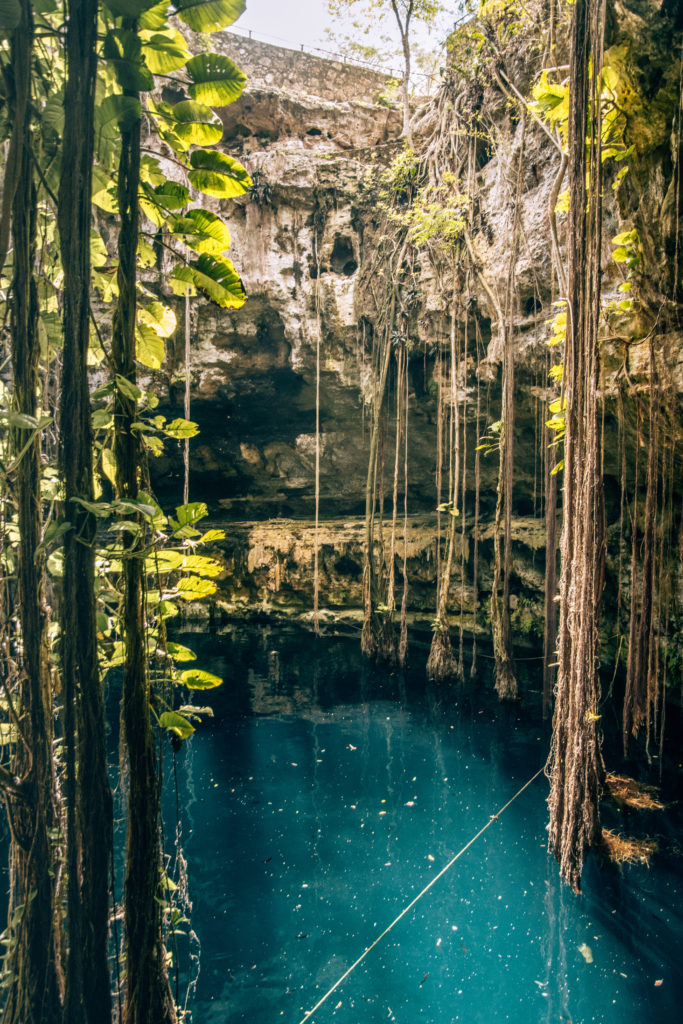
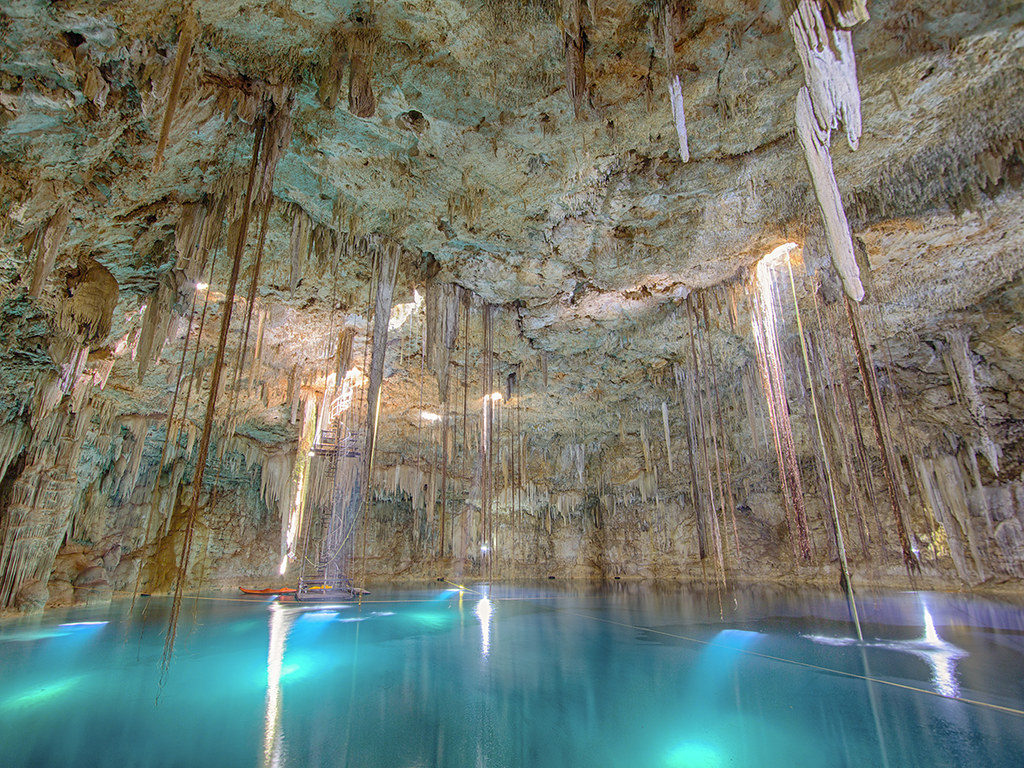
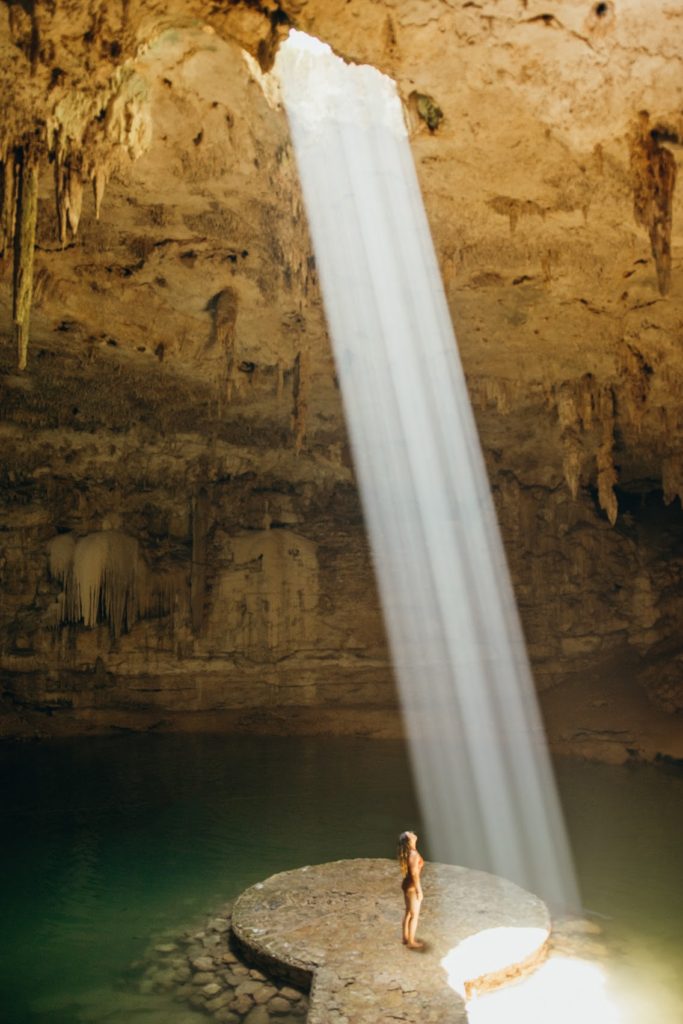
Once you depart from Valladolid, it’s about an 90 min drive north to the fishing village of Rio Lagartos. This is not your average touristy destination in the Yucatan (at least not yet), but it’s a great little spot that you should definitely add to your road trip agenda. Rio Lagartos is somewhat of a sleepy town where life is slow, but it’s a hidden gem waiting to be discovered.
There aren’t a ton of options of places to stay in Rio Lagartos, but our top choice would be Hotel Rio Lagartos for the outdoor pool, lounge, and location. It’s also a great value! For other accommodation options, make sure to check out all 8 properties on Booking.com, our go-to resource for finding the best deals on hotels and lodging.
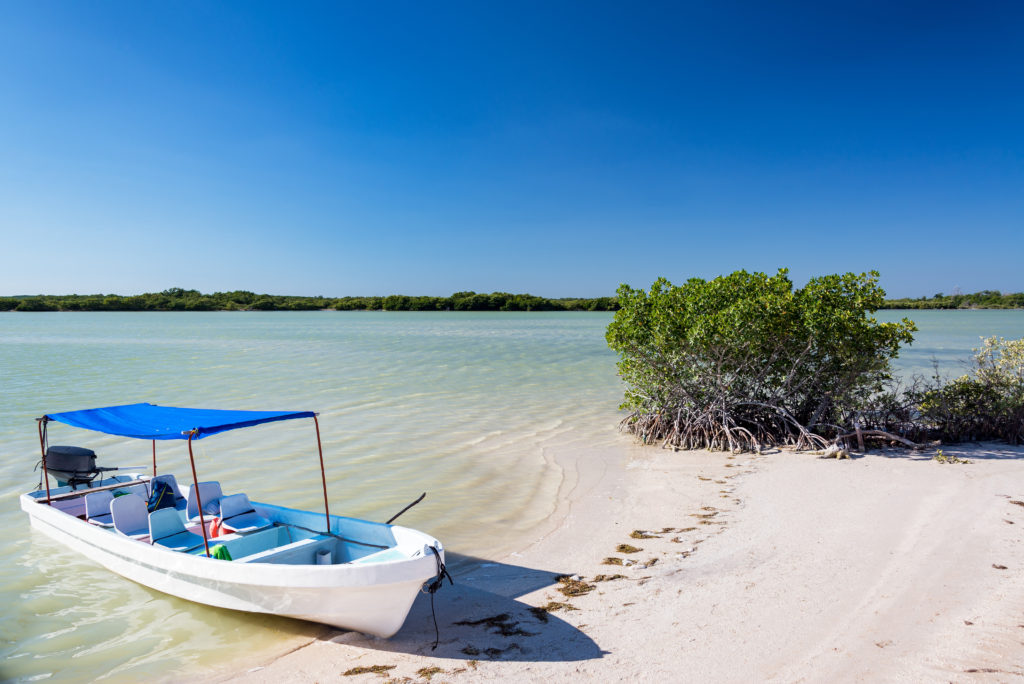
The two main attractions in Rio Lagartos are the Las Coloradas pink lake and UNESCO biosphere Reserve Rio Lagartos. You could essentially pack these into one day if you leave Valladolid early in the morning. Las Coloradas is pink due to its high concentration of salt which makes it a perfect breeding ground for algae which give the water the red color. It is located about 20 min from Rio Lagartos off a gravel road just before you reach the fishing village.
The fee is only 50 pesos and we wouldn’t recommend coming at sunset otherwise the pink color of the lake won’t be as obvious.
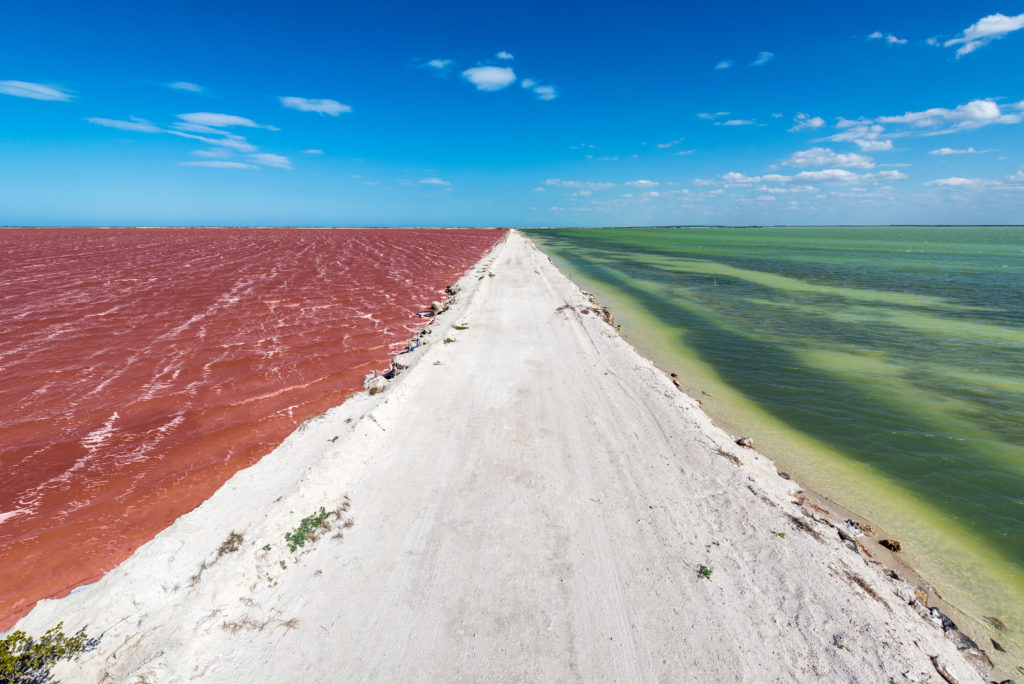
After you’ve gotten your fill of the pink lake, a trip to Rio Lagartos Biosphere Reserve is in order. This is the main attraction in the area and will be a highlight of your Yucatan road trip. With over 400 different species of birds–from herons to even flamingos (if you come in April and May), this is bird-lover paradise. There are also lots of crocodiles here too.
The best way to visit this incredible reserve is to go on a guided tour. When you are strolling around town along the waterfront, you will find several people offering tours to the Biosphere Reserve. The average price is about 300 pesos per person not including the 50 peso entrance fee into the park. You will learn a lot about this reserve, the wildlife and your boat captain will take you to some neat places you wouldn’t normally see on your own. Well worth the trip!
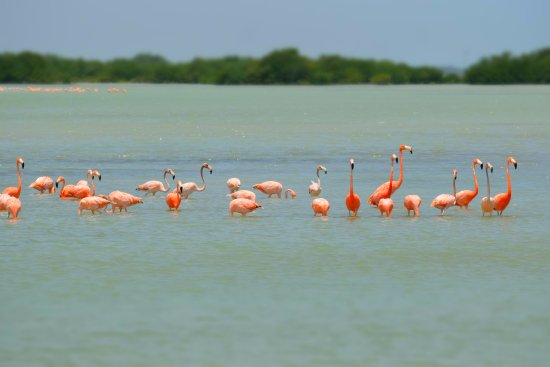
Only a short drive from Rio Lagartos, is El Cuyo, an up-and-coming beach town, world famous for kite surfing and pristine beaches. The best part? There are hardly any tourists, so chances are if you come here, you will not see many people. Like Rio Lagartos, there aren’t a ton of lodging choices, however there are still some great options without breaking the bank. We would recommend Casa Cuyo or Hotel Casa Cielo, both reasonably priced!
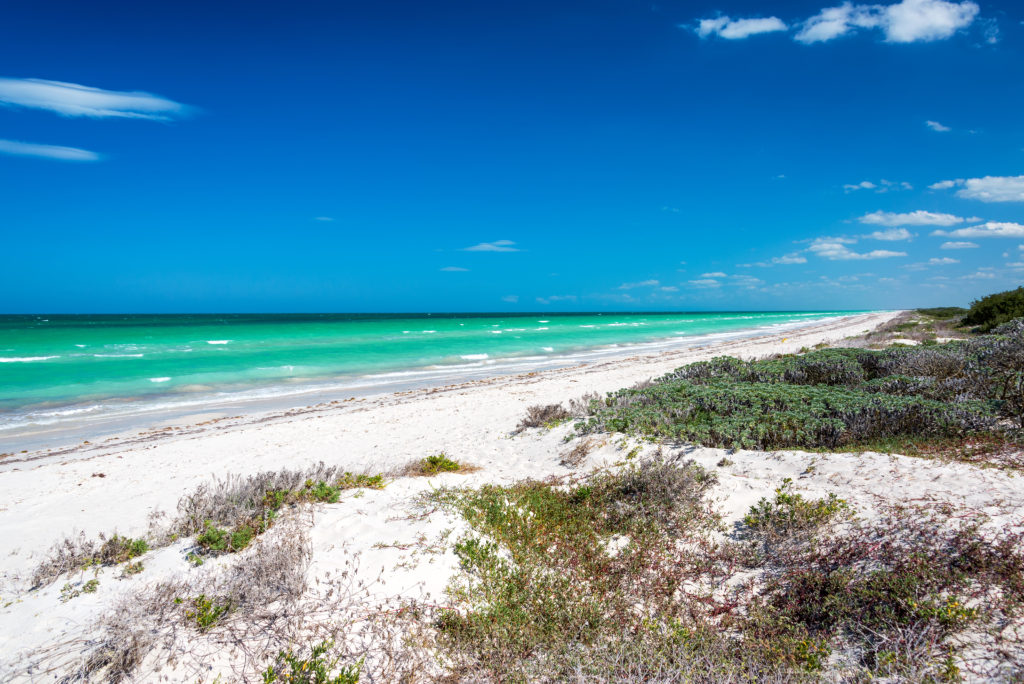
Besides kite surfing, there are some amazing beaches with green-blue water and white sand as far as the eye can see (less seaweed here too than many of the beaches between Cancun-Tulum too!). You can spend a day chilling and relaxing at the beach or if you’re feeling extra adventurous, take some kite surfing lessons with Extreme Control Adventures.
Don’t expect to be flying on a kite with a board strapped on your feet with just a lesson or two, but you will have fun learning how to control a kite on the beach, along with proper technique and safety. Trust us, it’s FUN and your kids will love it!
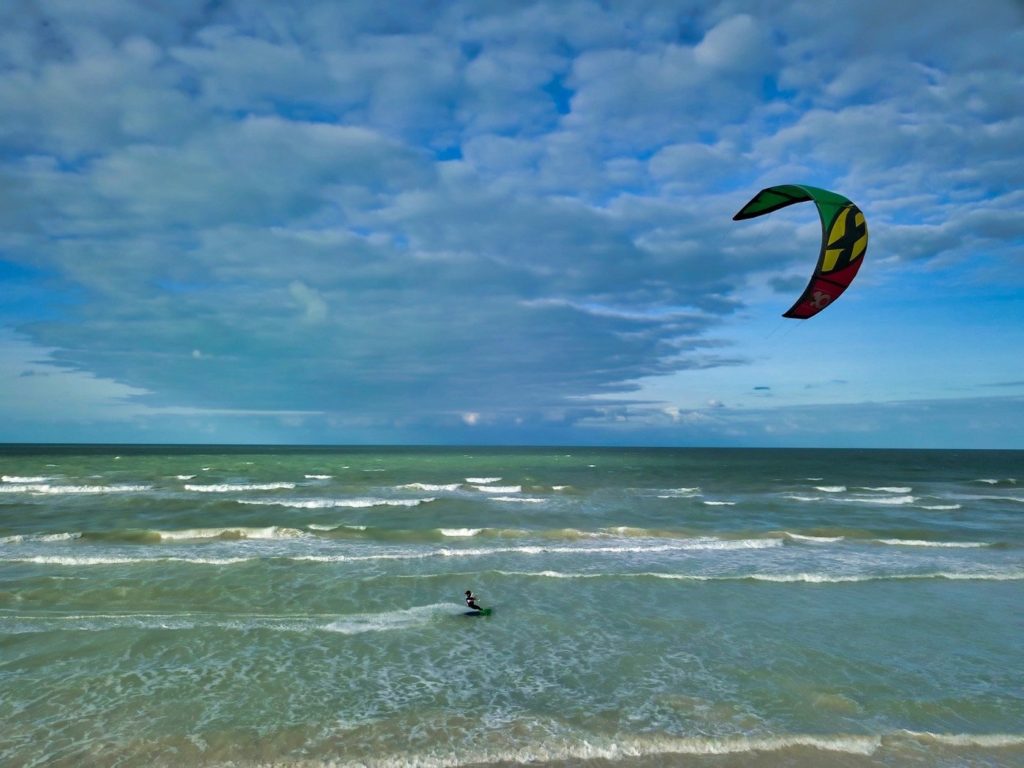
The last stop on the 10 day epic Yucatan, Mexico road trip is to the island of Isla Holbox. Most people know Cozumel or even Isla Mujeres, but Isla Holbox is up-and-coming and is still a little off-the-beaten-path. This small island, about 6 miles off the mainland north of Cancun is mostly car-free and mainly occupied by protected Biosphere Reserve.
The best way to get around Holbox is by golf cart or bike and there are plenty of rental companies you can rent from for a day or two. *Tip: If you rent one off the main square, you can find rentals for $50-60/day opposed to $90/day. For a good budget conscious place to stay on Isla Holbox, we would recommend Hotel Casa Iguana or Hotel Villas Tiburon.
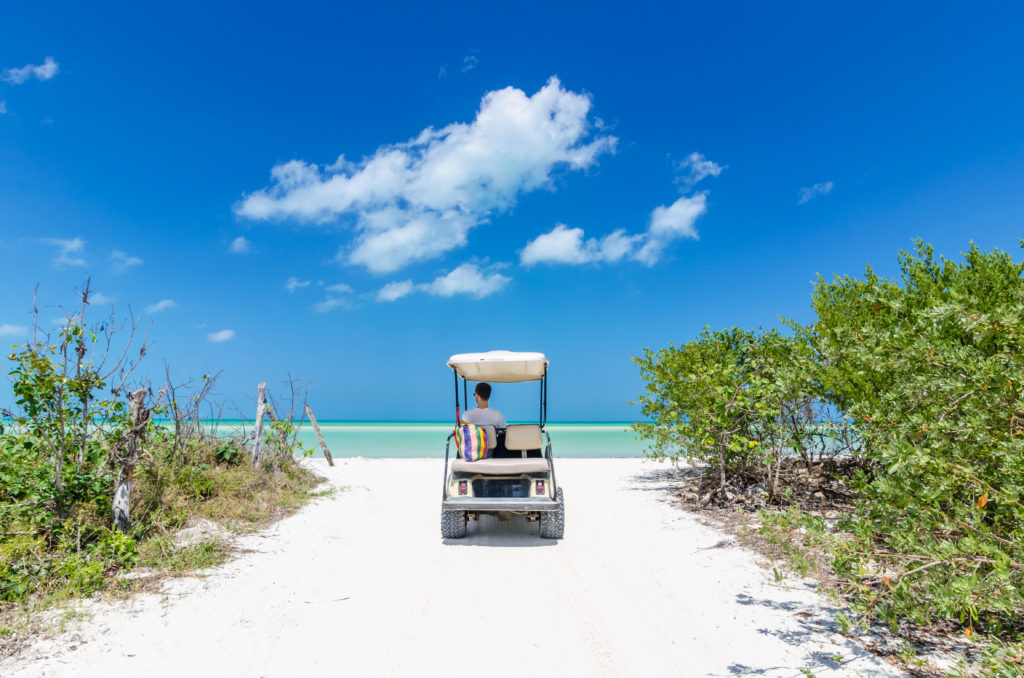
To get to Isla Holbox, you take a boat via 9 Hermanos or Holbox Express. Ticket prices are about $8 USD one way as of March 2019. There is a boat every 30 minutes between 6:00am and 9:40pm. Boats are never full and there is no need to buy a boat ticket from Chiquila to Isla Holbox in advance.
The best thing to do in Isla Holbox is go to the beach! The water is warm, incredibly blue and shallow and the sand is perfectly soft. There are also plenty of hammocks made for napping and relaxing! In addition, make sure to watch the sunset one night from Whaleshark Pier. It sounds like a simple thing but at the end of the day everyone gathers around the pier just two blocks away from the main square.

If you have another day on Isla Holbox, we would recommend a few things. One is to swim with whale sharks if you happen to be in the Yucatan between June-September. This is a bucketlist experience! You can also see bioluminescent plankton at night during this season too. Other options include the 3 island boat tour, kayking through mangroves, or walking the sand bank to Mosquito Point at low tide.
That concludes the 10 day epic Yucatan, Mexico road trip! With this itinerary you get a good taste of all the best things Mexico has to offer!
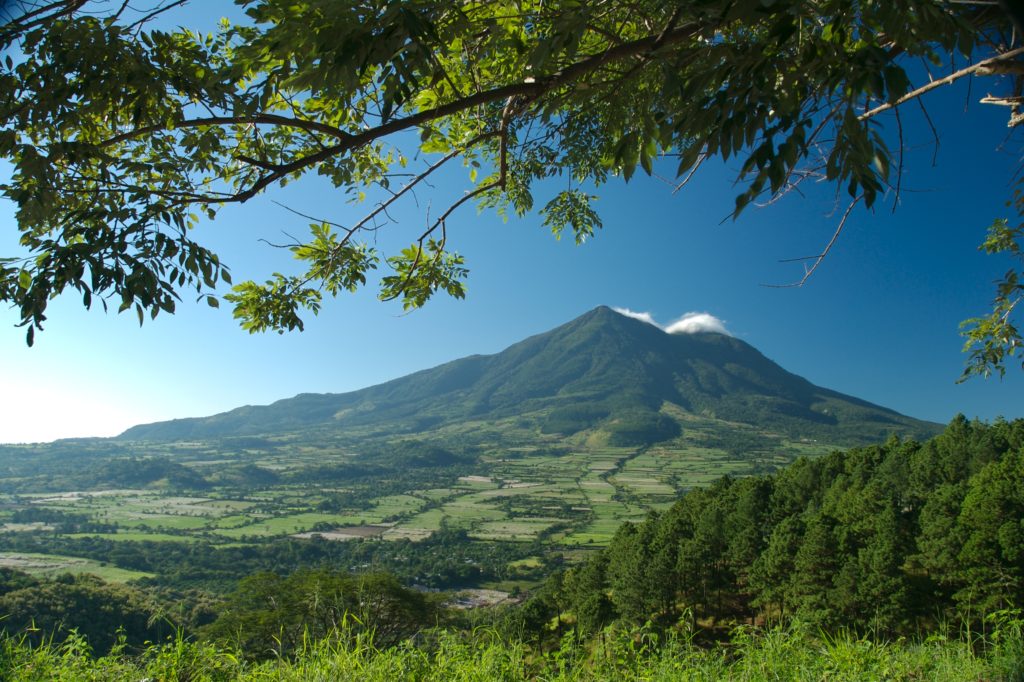
El Salvador just might be Central America’s most underrated country. When you compare more popular, nearby countries such as Costa Rica, Belize, or even Panama, El Salvador is usually overlooked. And for good reason: over the past couple of decades, El Salvador has gotten a bad reputation for not being a safe place to travel to. And while there used to be some truth to that, it is simply not the case anymore. After spending almost a month in this country, we fell in love with the beautiful landscape, the culture and the food. That’s why we came up with this El Salvador Adventure Travel Guide.
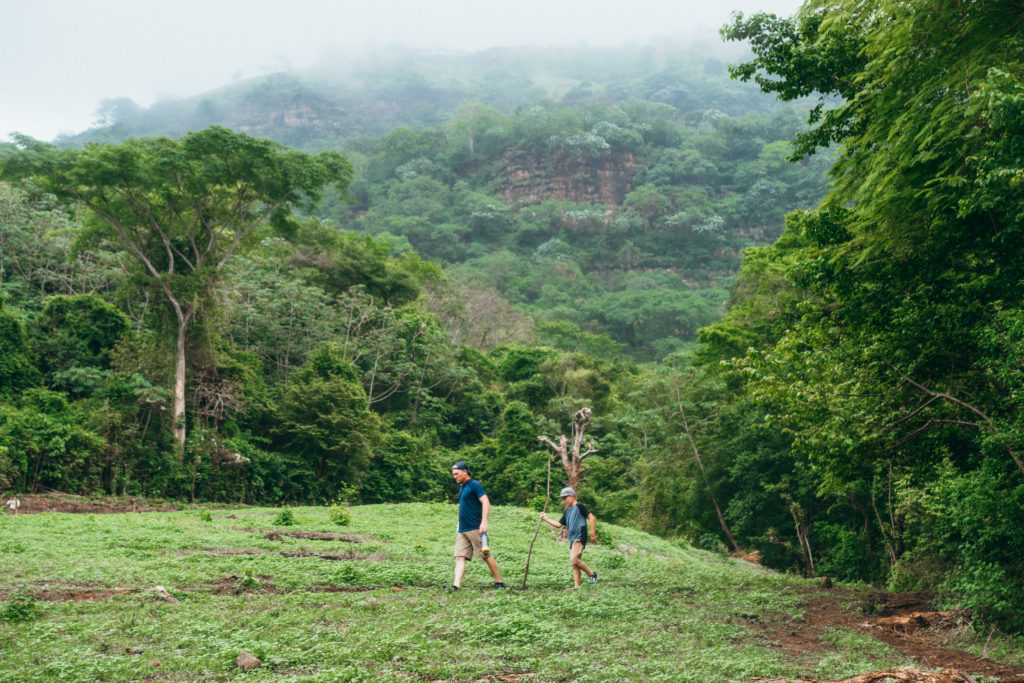
This is usually the first question that comes up when one mentions traveling to El Salvador. Due to decades of gang/drug violence and civil war, El Salvador has earned a bad reputation for being unsafe to travel to however, in recent years that has changed. In fact, in Oct 2019, the U.S. State Department just downgraded El Salvador from a travel advisory rank of a 3 to a 2.
Just to put things in perspective, 4 is the highest (meaning do NOT travel to) with countries like Venezuela, Iran, Syria, Afghanistan and North Korea because of war zones. Now that El Salvador is ranked a 2, that puts it in the same category as countries like France, Denmark, Spain and Guatemala (“exercise increased precaution”).
Now, this doesn’t mean that gang violence doesn’t still exist–but generally it is just in certain areas of the country and the violence doesn’t involve tourists because it is aimed at other gang members. So, as a tourist, you are largely safe. Just like any city or country, you should use good judgement such as don’t walk dark alleys or sketchy neighborhoods at night, don’t draw attention to yourself with flashy clothes and jewelry, and never leave your valuables in your car.

You could spend a week in El Salvador and see a lot since it’s a small country, however, you will still barely scratch the surface. This country packs a powerful punch. We recommend staying at least 10 days in El Salvador, however if you’re on a tight schedule, a week is plenty of time to see some of the country’s best highlights.
The one thing we would highly suggest is renting a car (contrary to what you may hear, it’s totally safe to drive here!) and then doing a road trip through a few areas of El Salvador, however if you are on a strict budget, there are plenty of buses that are easy and cheap to get around with!
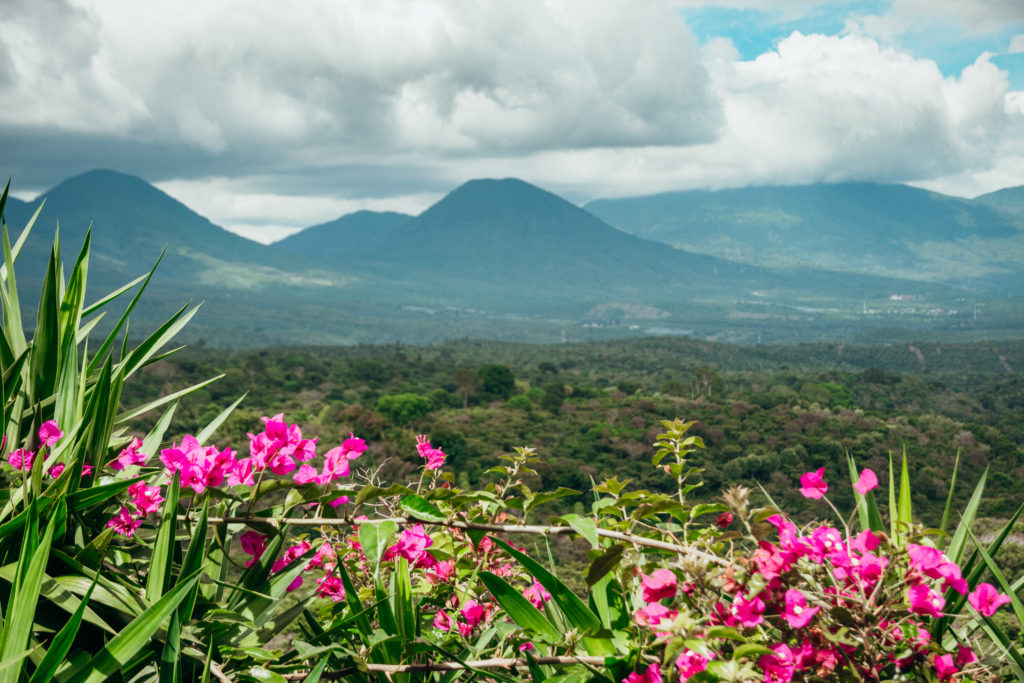
We would recommend picking a few spots and spending 2-3 nights at each place since the best areas of El Salvador are a bit spread out. One area is the coastal region of El Tunco and El Zonte. You can’t come to El Salvador and not go to the beach! The beaches along the Pacific coastline are incredibly beautiful and rugged, and also known for world class surfing!
We especially loved Puro Surf for their top notch surf academy, but also the views and food are out of this world! You can find other great lodging options through Booking.com which is our go-to resource for finding the best accommodations for your budget!




Another area to consider visiting for a few days is the Southern coastal region of Costa del Sol or our favorite, La Flores. You will find less people here and pristine, untouched beaches that stretch for miles. We recommend staying at Vista Las Olas which is beautiful beach front property right on the Las Flores beach. Perfect for surfing, or just getting away and enjoying the nature.


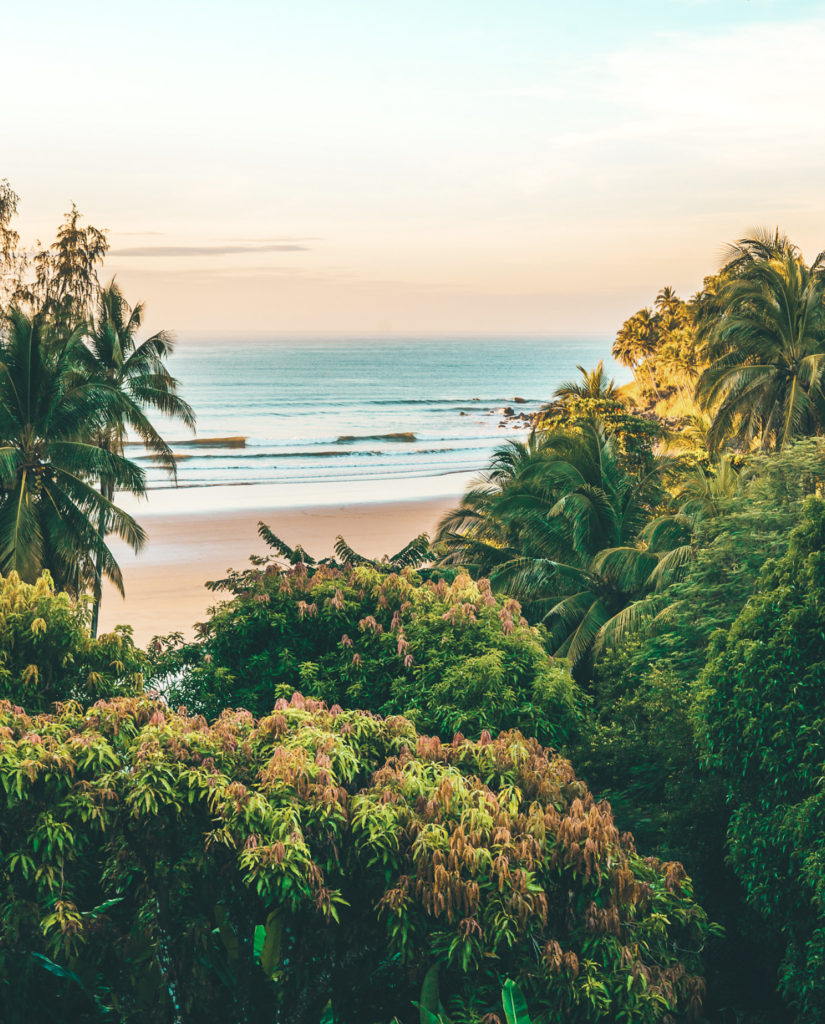
The last area of El Salvador we suggest staying a few days is in the mountainous region along the famous “Ruta de Las Flores” (more on that later). We stayed at a great hostel in Juayua, called Hostal Casa Mazeta, right in town which is central to many of the sights and activities that we enjoyed in the area. Highly recommend this place!
If there’s one thing for certain, you won’t get bored in El Salvador. From surfing, to hiking, to taking in the tastes of the famous pupusas, there is no shortage of adventure and culture here. Not only that, but Salvadorians are some of the warmest, most welcoming people you will ever met. Of all the Central American countries we’ve visited, our favorite people were the Salvadorians. They are genuinely excited you are visiting their country and eager to show you their wonderful country.

Hike Santa Ana Volcano
Assuming you start your trip in San Salvador, we would recommend heading to the city of Santa Ana first. It’s only an hour drive and beautiful. You will pass volcanoes, coffee farms, and rolling hills. The town of Santa Ana is quaint. Don’t skip seeing the Cathedral de Santa Ana and the main plaza, Parque Libertad. If you’re looking for a good place to stay for a night, make sure to check out Hostal Casa Verde.
The main attraction here is the nearby Santa Ana volcano. Santa Ana is the tallest volcano in El Salvador and quite unique because of its four nested concentric craters, one inside the other, as a result of many eruptions and seismic activity and its beautiful blue lake in the innermost crater.





The Santa Ana volcano is the tallest and most active volcano in El Salvador because of its beautiful turquoise lake and great 360 degree views from the top. From the rim you have a vantage point over the two other volcanoes, Idalco and Cerro Verde, the ocean on the horizon and Coatepeque Lake on the other side of the volcano. The entire hike is about 8 miles round trip and moderately challenging.

To start the hike, you will need to leave the town of Santa Ana early in the morning (no later than 8AM) to enter Cerro Verde National Park, so you can start the hike around 10-11AM with a ranger. *Note: You have to do this hike with a guide and a police escort due to robberies and theft that have happened here. Groups can be small or large depending on the time of year and day, however once you get started on the trail, you will find that the group disperses.
Entrance fees including guide and entry fees are around $10/person. This hike is definitely a MUST when you travel to El Salvador.
Explore the Ruta de las Flores

One of the things that El Salvador is most known for is the famous Ruta de Las Flores, or route of the flowers. Basically, the Ruta de las Flores is a winding route about 20 miles long that goes through brightly colored towns, coffee plantations and fields of wildflowers (between Nov and March is the best time to witness the flowers). There are 5 main towns along the Ruta de las Flores: Juayua, Ataco, Apaneca, Nahuizalco, and Salcoatitlan. The first 3 are the most noteworthy.
You can easily spend a day discovering these towns which have colorful murals, shops and plenty of delicious cafes to get some good pupusas (our favorite was Esmeralda’s in Juayua!) and coffee. There is also a giant labrinyth in Apaneca if you like mazes. Also, don’t miss the food market in Juayua, but come on a weekend! If you’re a big coffee drinker, you can also do a coffee plantation tour just outside of Ataco.




We would suggest spending a minimum of 2 days in the area, and staying in the town of Juayua (as recommended previously, we loved staying at Hostal Casa Mazeta). There are several outdoor activities you can do in the area, but a few we would suggest NOT skipping would be the Los Chorros de la Calera (7 Waterfalls) hike, the hot springs, and the canopy/zipline tour in Apaneca.

The 7 Waterfalls hike starts in Juayua and if you stay at Casa Mazeta, they can book it for you. It costs about $10-15/person (including lunch) depending on the size of group you have. Of course, this covers the guide (which you need otherwise you will get lost), but also the gear they provide (a helmet) since this hike requires rappelling down waterfalls! It is somewhat of a challenging hike (not ideal for young kids), but absolutely worth it! You will pass through jungles, coffee farms and see volcanoes, and of course several waterfalls!





The hike itself may feel a little sketchy at times rappelling down waterfalls with only a rope and a helmet (no harness!), however, the guides are right there making sure you’re safe. Honestly, it didn’t seem as sketchy as it looked. The last waterfall you can swim in, and it feels great after a hot day hiking in the jungle!
There are a few hot springs along the Ruta de Las Flores that are worth going to, some free and others paid. Termales Santa Teresa is located in the town of Ahuachapan and costs about $10/person. These hot springs are beautiful and lush, however if you’re on a budget and want to visit free hot springs, check out Salto de Malacatiupan, located just outside of Ahuachapan. Amazing!

One more area of interest to note: Right on the edge of Guatemala, the mostly primary forest of Parque Nacional El Imposible shimmers with rivers and beautiful waterfalls. Hiking can get muddy and steep, but it rewards with panoramas of misty peaks and the Pacific Ocean off to the west. The best time to visit is October to February, as the rainy season hinders travel. There are several hiking trails to explore if you choose, however we would suggest doing a guided tour.

Go surfing
After spending several days inland exploring the mountainous regions of El Salvador, it’s time to head to the coast. El Salvador is known for its surf and draws some of the biggest names in the surf industry to its rugged Pacific coast every year. We came to El Salvador to learn to surf, primarily because it’s so much cheaper to take lessons here than other Central American countries like Costa Rica or Panama. For $10-15/lesson, you can easily take a whole week’s worth of surf lessons for dirt cheap and get the basics down. Plus, it’s just AWESOME!




The most popular areas to surf in the country are the area of El Tunco/La Libertad and El Zonte, located about 45 minutes west from the San Salvador airport. We took several lessons from the pros at Puro Surf and had a blast. Their surf academy is top notch–in fact, we’ve never seen anything like it!
From yoga and fitness classes designed for surfers in mind, to a skate ramp to learn balance and turning, to a lap pool specifically for practicing your paddling, Puro Surf has it all. They are serious about getting you off on the right foot (literally) and ensuring that you learn proper stance and form first, before heading out the ocean. And trust me, it’s a GAME CHANGER. On our very first wave, we all got up!

Some of other great beaches for surfing in El Salvador include Punto Mango, Las Flores, Playa Conchalio, Sunzal, and Punta Roca. We also loved El Cuco which wasn’t as rocky as some of the others. Also, it is important to note that if you are a beginner surfer, the best months to surf are between December to April. After that, the swell gets bigger and stronger in the wet season (May to November).
Visit Tamanique Falls

Not far from El Tunco, about a 30 min drive east into the mountains lies this gem, Tamanique Falls. This is a great place to cool off, as the coast gets very hot and humid. The Tamanique Waterfalls is a group of 4 waterfalls, where you can jump off 3 of them. The last waterfall has a pool where you can swim and relax in just below the waterfall. The hike takes about 30-45 minutes to reach the falls from the town of Tamanique.
You can also catch a bus from El Tunco to Tamanique (look for the bus with the sign “Tamanique” on it) which takes a bit longer than driving yourself. To find the trailhead once in town, simply ask a local in town and they will direct you. If you don’t feel confident going on your own, many of the locals are willing to take you for a small fee.




Watch the sunrise from Espiritu de la Montana
From the El Tunco area, if you drive south a few hours, you will eventually get to the Las Flores area mentioned above. We highly suggest setting up base here and spending a couple of days surfing or relaxing at some of the beaches in this area. They were the most beautiful beaches we witnessed in all of El Salvador. Don’t be afraid to ask the locals for their faves too!
About an hour south of Las Flores is the town of La Union which is located right on the Gulf of Fonseca, a beautiful gulf that borders 3 countries–El Salvador, Honduras, and Nicaragua. Here lies Volcano Conchagua, which overlooks the Gulf of Fonseca.

At the top of Volcano Conchagua is a lookout, named Espiritu de la Montana, and the best time of day to witness the view of this gulf is at sunrise. This requires camping here for a small fee. To climb to the top, you can either drive your a 4 X 4 up the dirt road or you can also hike to the highest point (about 3 hours). At the viewpoint you can camp on the wooden deck or if there is a lot of wind you can camp in the forest. There is also a basic shop and restaurant here too. Definitely worth the trip–best view in all of El Salvador!

El Salvador is a country that is just waiting to be discovered. It has been called the “next Costa Rica” and after spending a few weeks in this incredible country, I’m convinced tourism is only going to rise here. Our advice is get here before everyone else finds out about it!
If you’re looking for off-the-beaten path adventures in the underrated, neighboring country of Guatemala, make sure to check out 8 Outdoor Family Activities in Lake Atitlan, Guatemala, or 3 Days of Adventure in Semuc Champey. Guatemala is another incredible country that often gets a bad rep, but far exceeded our expectations in every way.
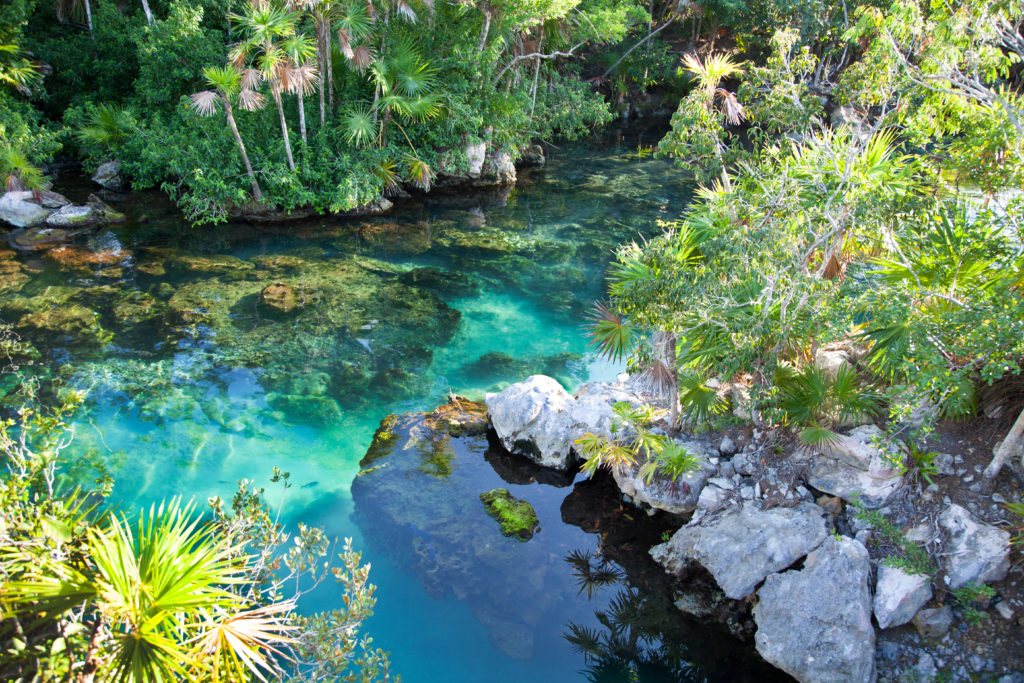
The Riviera Maya is a prime destination for a family adventure vacation with some of the world’s most gorgeous beaches, Mayan ruins, amazing reef, and thousands of cenotes dotting the peninsula. A cenote is basically a giant sinkhole in the ground resulting from the collapse of limestone bedrock. Most cenotes in Mexico are filled with fresh water, making them ideal swimming holes. We’ve uncovered 18 top cenotes for kids in Mexico, with tips on where they are located, cost (adult pricing), and other helpful tips!
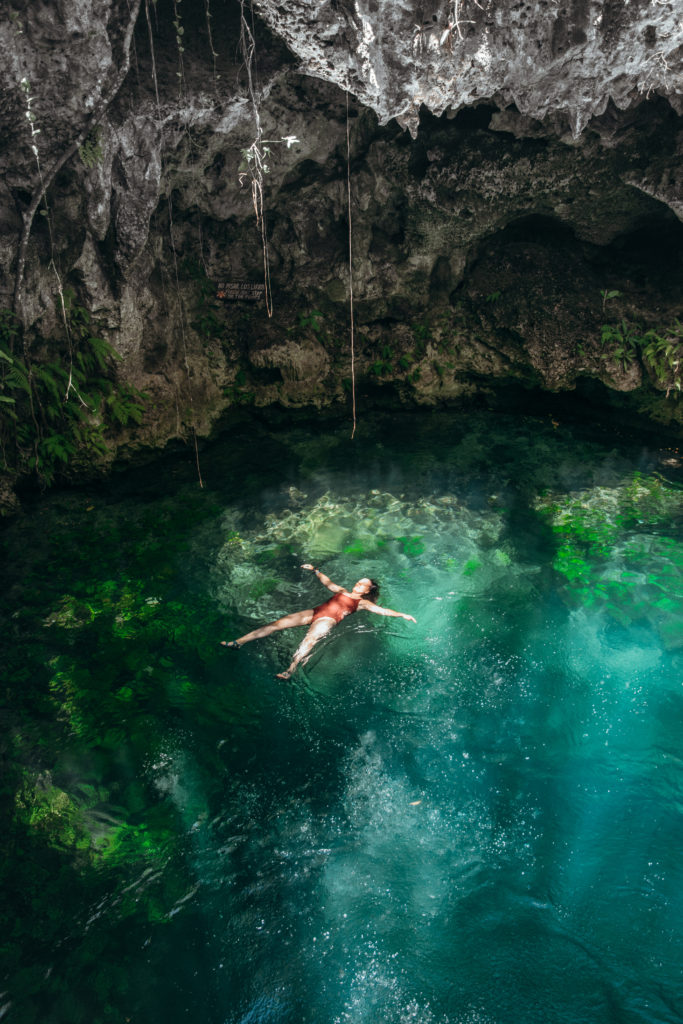
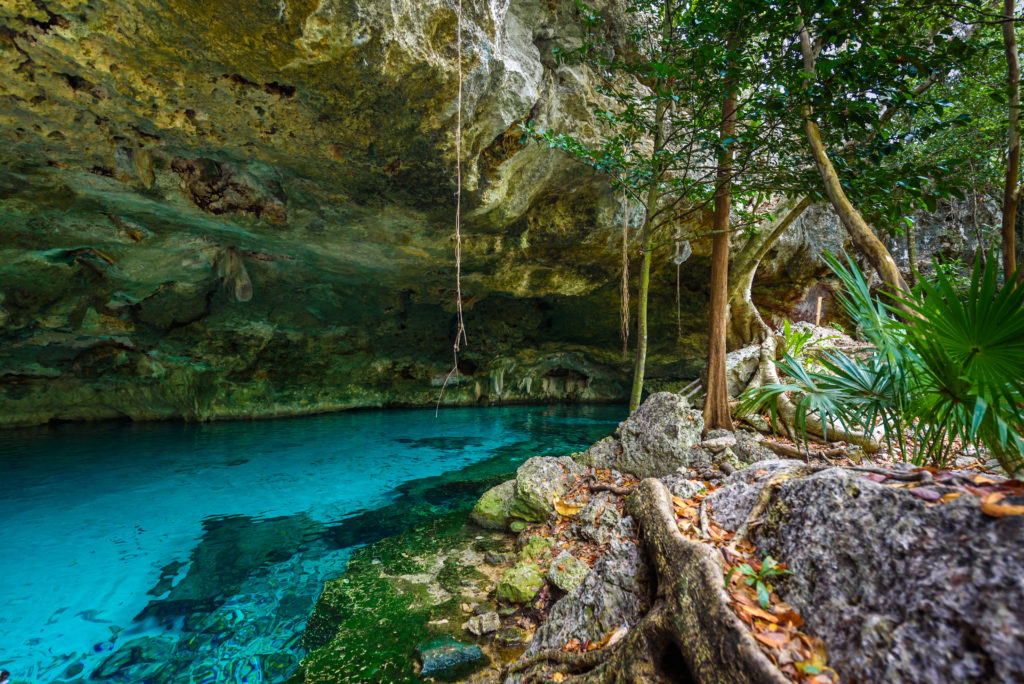
The very first cenote we ever visited back in 2016 just happened to be Dos Ojos, which is world famous for being the largest underwater cave system! Dos Ojos means “two eyes” and describes it’s two pools of water: one super blue for snorkeling and the other is dark for diving! We didn’t dive here, but we did snorkel and let’s just say it was amazing! The clarity of the water is astounding and there are incredible stalagmites and stalactites everywhere you look.
This cenote is one of the most popular cenotes in the area (for good reason), so we suggest coming right when it opens or right before it closes. You can also rent snorkel equipment here if you don’t have your own, but obviously it’s cheaper to bring your own.
Cost: 300 pesos ($15 USD)
Hours: 9AM-5PM
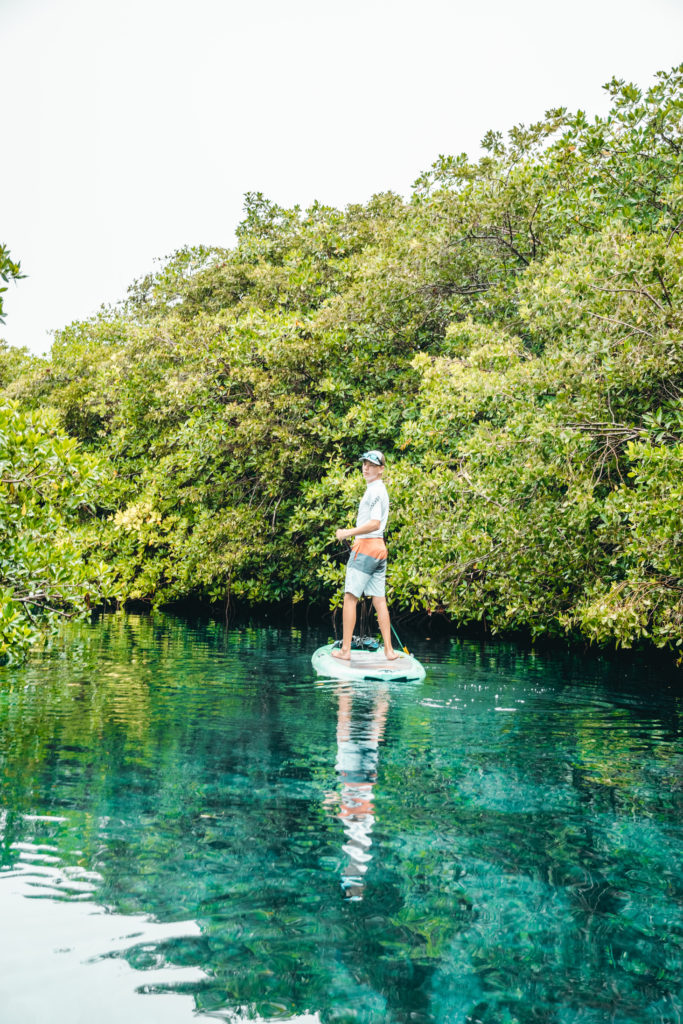
Cradled between a crystal-clear fresh water cenote and a sandy white beach on a turquoise Caribbean bay is where you’ll find Casa Cenote. Framing the western shore of Casa Cenote also known as “Cenote Manati,” is named for the manatees who have swam in their waters over many years. Casa Cenote is a great place to snorkel, paddleboard or kayak (both of which you can rent here). It’s also a popular place to learn how to scuba dive.
We spent a day paddleboarding with Extreme Control Adventures in Casa Cenote and nearby Soliman Bay. Definitely a place you should add to your list!
Cost: 120 pesos ($6 USD)
Hours: 9AM-5PM
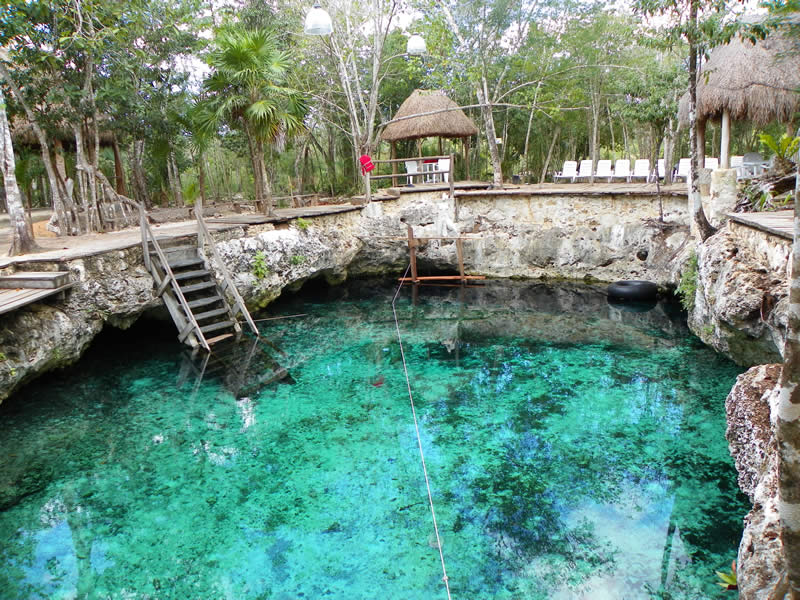
Zacil-Ha is located just outside of Tulum and is known as one of the best family-friendly cenotes on the Yucatan. This wasn’t our favorite cenote because it was more “commercialized” with a snack bar, but it is a great cenote with kids, easily accessible, and cheap.
Cost: 80 pesos ($4 USD)
Hours: 10AM-5:30PM
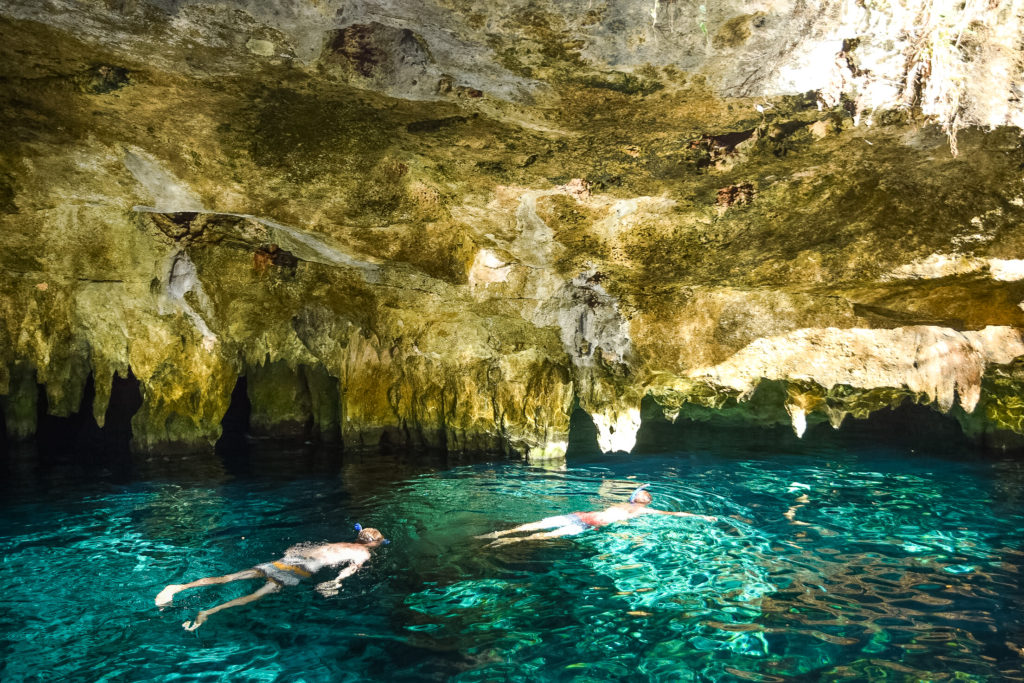
Worth the hype? Gran Cenote might be one of the most well known cenotes in the Riviera Maya, but trust us, it’s worth going to. Our top tip for visiting this cenote? Go early in the morning right before they open to avoid many people. Bring snorkel gear if you have it (otherwise you can rent there) as there are amazing caves to explore and turtles! The water is super clear and really beautiful.
Cost: 180 pesos ($9 USD)
Hours: 8AM-4:15PM
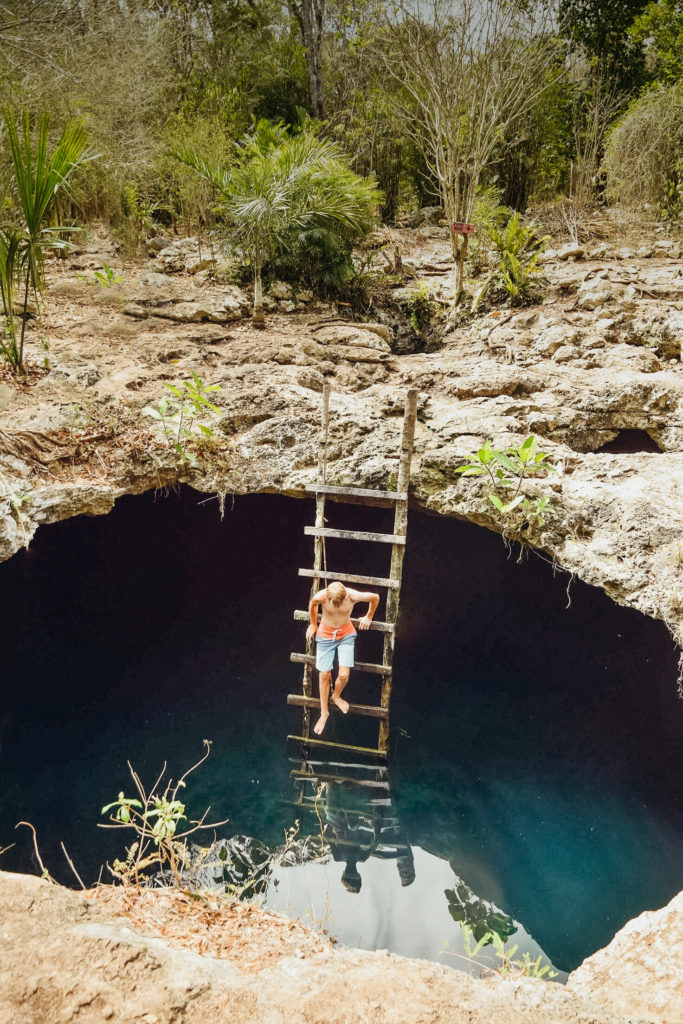
Calavera is a circular-shaped cenote near Gran Cenote, off the main highway towards Tulum. It’s not a big cenote, but it’s a fun one! There is a ladder that descends into the cenote, but what makes it fun is jumping into it from the ledge. There are even some smaller “holes” you can jump into but don’t worry, the water is plenty deep.
Cost: 100 pesos ($5 USD)
Hours: 9AM-4PM
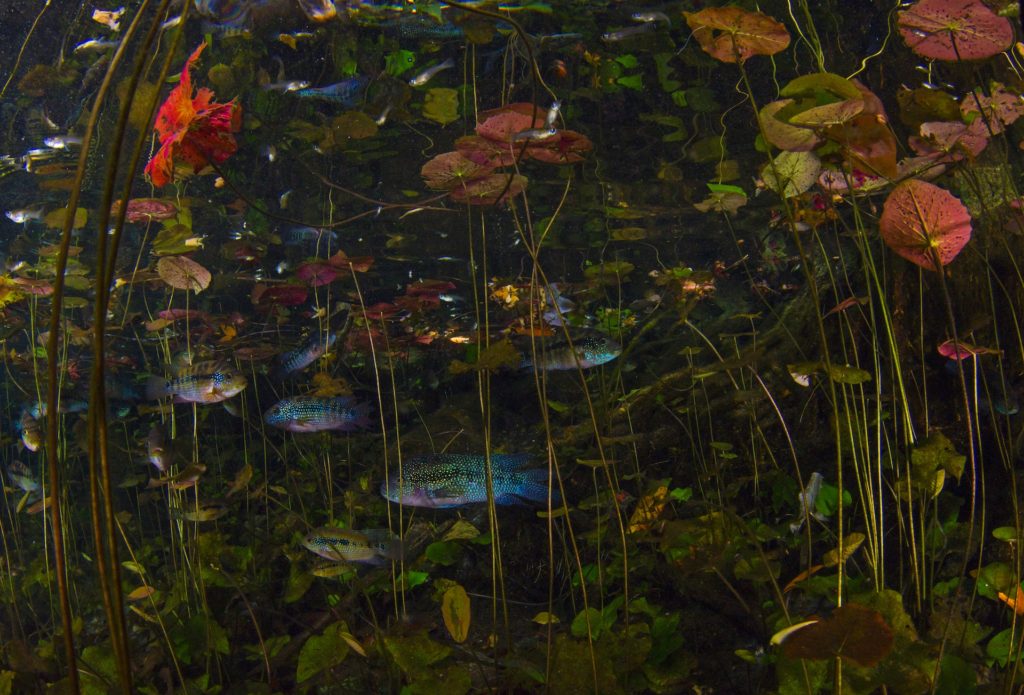
Officially, this swimming hole is called Aktun Ha Cenote, but most locals know it as the Car Wash Cenote. It got its name because it’s only a minute or so off the road, so many taxi drivers would stop by to clean their cars in hot, dusty weather. This one rarely gets super crowded too, which is a plus. Underwater, there are a large variety of plants and fish which make it great for snorkeling.
Cost: 50 pesos ($2 USD)
Hours: 9AM-5PM
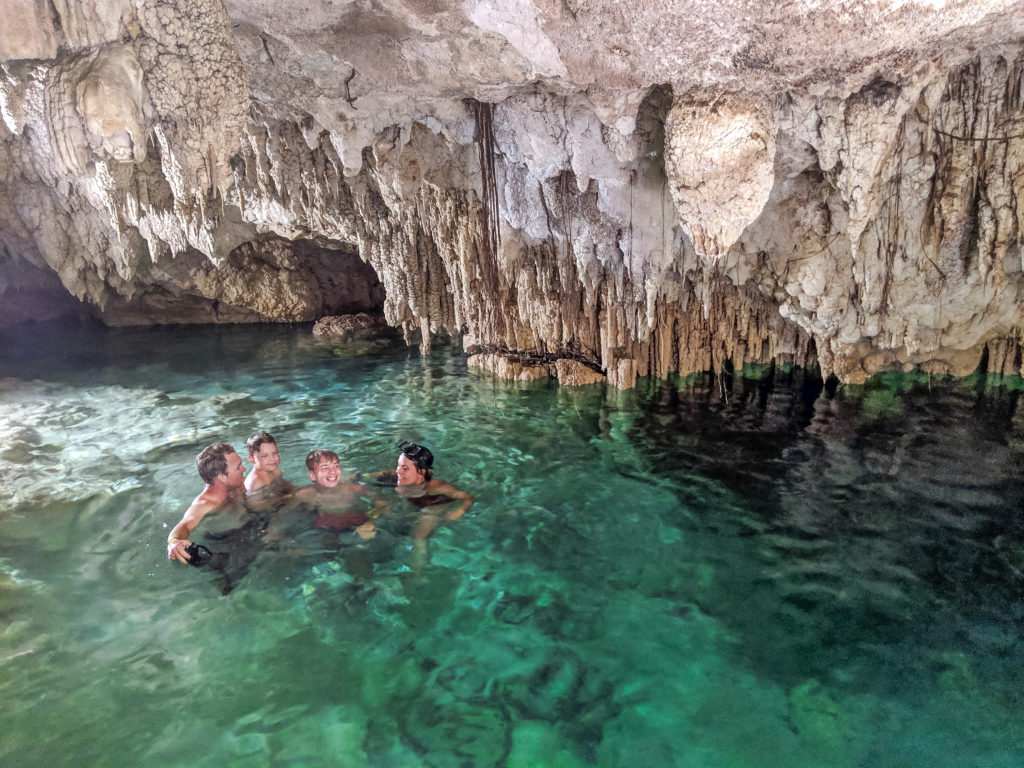
Four different cenotes make up Casa Tortuga so you could easily spend a few hours here. You have to go in a guided tour group, which might be a turn off, but what’s nice is once you are done, you can explore the cenotes on your own. We loved cliff jumping and swimming through the caves! The entrance fee includes the guide.
Cost: 350 pesos ($18 USD)
Hours: 9AM-5PM
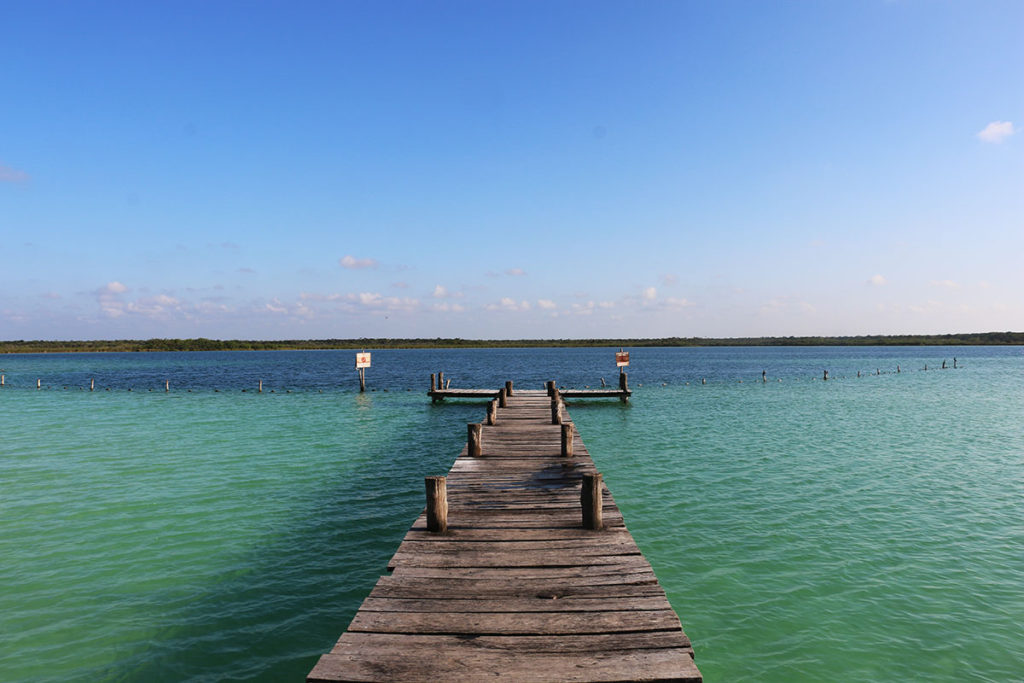
Laguna Ka’an Luum is one of our favorite cenotes because it’s off-the-beaten-path. It is located just south of Tulum, inside Sian Ka’an Biosphere Reserve. What makes Laguna Kaan Luum special is the color of the water and the fact the center is a deep cenote. Some say the center is about 80 meters (262ft.) deep. You can tell the color contrast between the center of the lagoon and the sides. This cenote is stunningly beautiful, hardly visited and teeming with wildlife.
Cost: 50 pesos ($2 USD)
Hours: 9AM-5PM
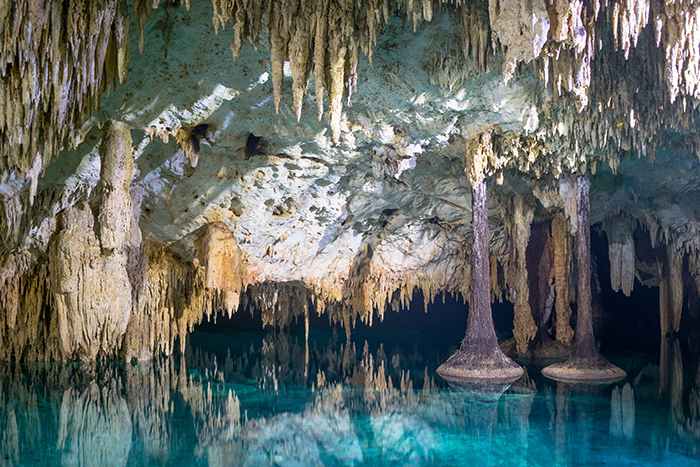
Cenote Sac Actun, also nicknamed “Pet Cemetary” is part of the Dos Ojos cave system, making it the largest underwater cave in the world. While it is completely underground, the entrance is open and provides a small area where you can float in beautiful turquoise water. This cenote is one you have to do with a guide, but it’s well worth it. You learn a lot about this fascinating and unique cenote and cave, but also get to see things you might miss without going on a guided tour. Keep in mind that the price includes a guide and lifejacket.
Cost: 450 pesos ($23 USD)
Hours: 9AM-5PM

Cenote Azul is a rather popular cenote just south of Playa Del Carmen in the Riviera Maya. Here you can enjoy seeing this natural area and taking a dip in the refreshing waters. This cenote is just next to Cenote El Jardin Del Eden and Cenote Cristalino which are very popular as well. Cenote Azul is an open cenote and shallow in most parts, making it good for kids.
Cost: 120 pesos ($6 USD)
Hours: 8AM-5PM
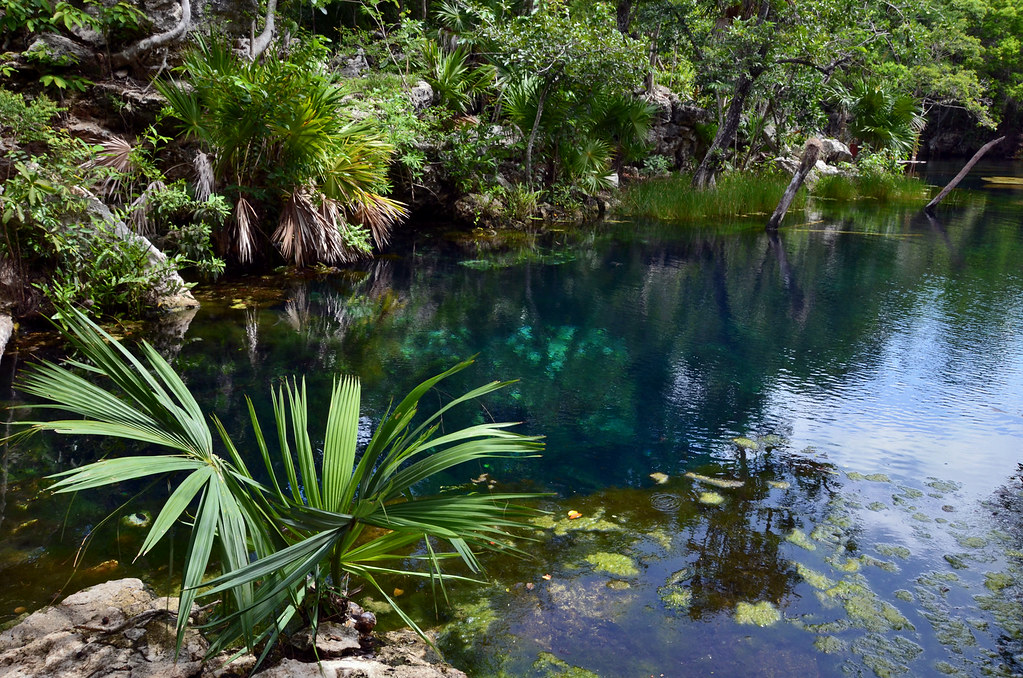
As mentioned previously, Cenote Jardin del Eden is near Cenote Azul, making it ideal for combining the two in one day if you choose. This cenote is open and makes for a lush surrounding area with plants growing in the water and the rocks covered in green moss. The water quality is really clear so we recommend bringing your snorkel gear.
On one end of the cenote there is a cliff for jumping. This is about a 12 foot jump, but there is a tree that people jump off of as well that will get you up even higher. In the middle of the cenote are rocks that were once part of the roof and now are submerged about 1 foot underwater. This make for a nice place to rest.
Cost: 200 pesos ($10 USD)
Hours: 7AM-5PM

Cenotes Chikin Ha are made up of a group of 3 cenotes (Chikin Ha is the main one) that offer a little bit of everything–zip lining, diving, snorkeling, and swimming. The cenote Chikin-Ha has two entrances, and underneath the water you will find an underground world. The sunlight touches different parts of the cenote, so the colors of the cenote changes every time.
Cenote X’tabay is a beautiful open cenote, which display several plants and animals. Here you could find fishes, turtles, water lily, Ceiba trees and more. This cenote is perfect for kids where they can swim and snorkel in relative shallow water and they still can explore a cave. Cenote Ta’ak Bil-Ha is a ceremonial cenote where Mayan priests still do some rituals. You cannot swim here, but this cenote offers several trees that reach the water with their roots.
Cost: 400 pesos ($21 USD)
Hours: 8AM-6PM
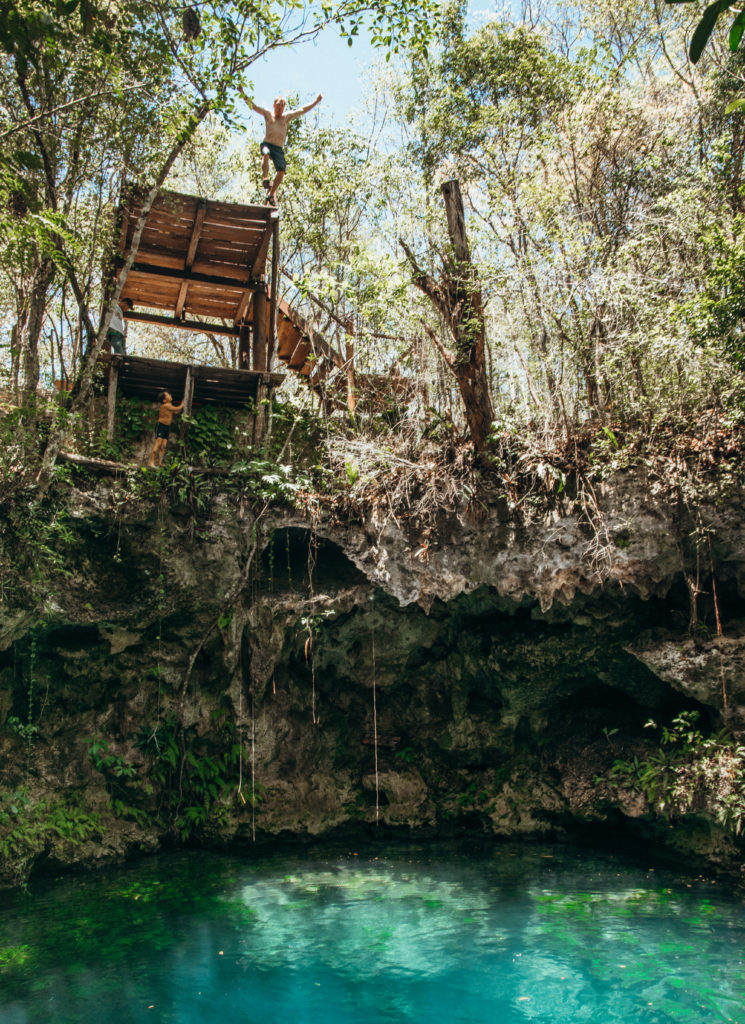
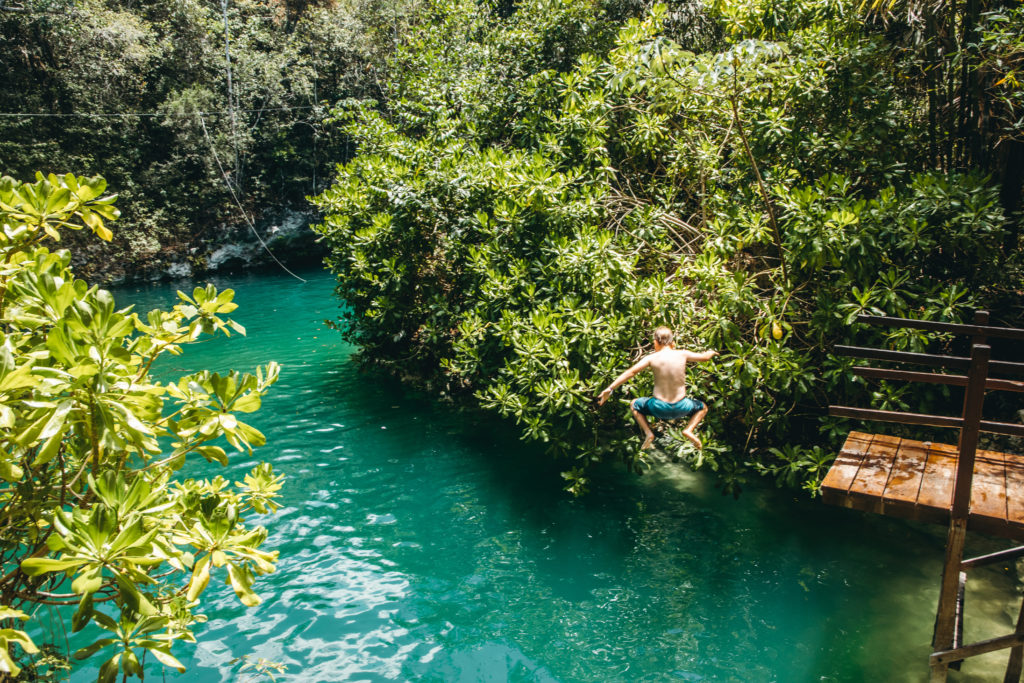
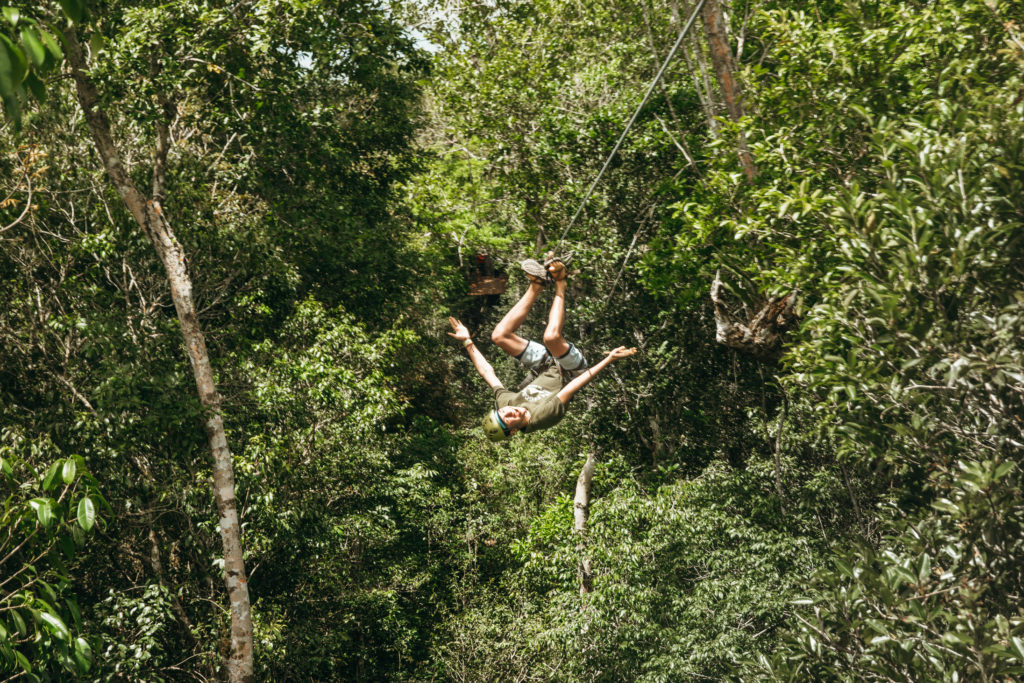
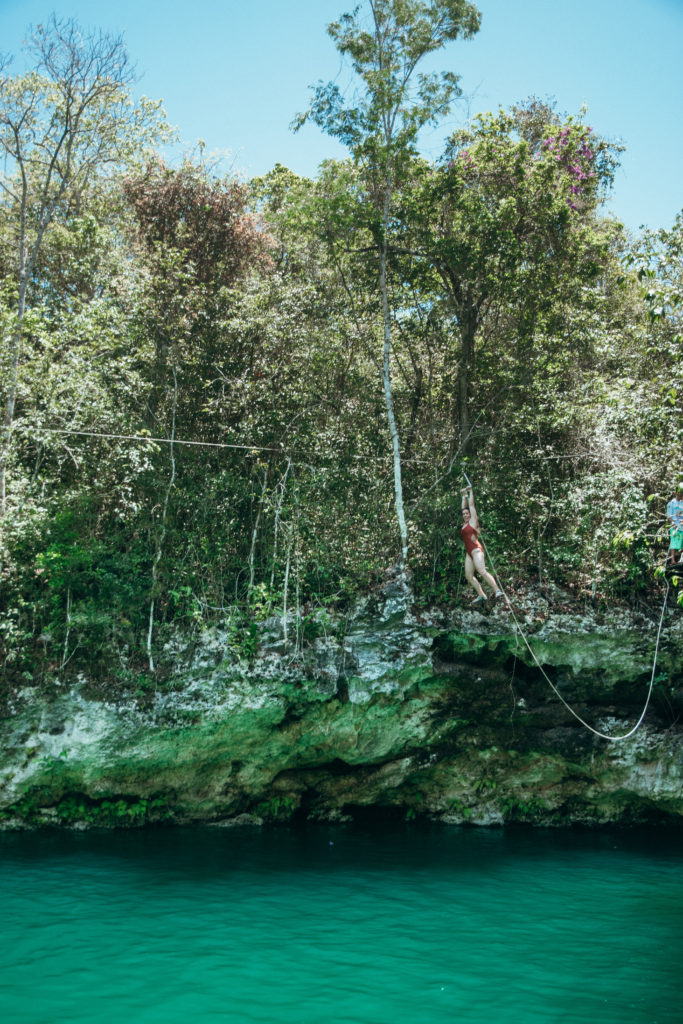
Cenotes Zapote is made up of several cenotes found inside of this natural eco-park, just outside Playa del Carmen. The park contains zip lines, mountain bike trails and of course, cenotes. We absolutely loved the cenotes here because they offered a taste of everything–snorkeling, zip lines, and cliff jumping! Perfect for families with kids of all ages.
Cost: 200 pesos ($10 USD)
Hours: 9AM-5PM

Some of Mexico’s best cenotes are near Valladolid, which is located in the center of the Yucatan peninsula. We took a road trip there from Tulum and spent a couple days exploring different cenotes, ruins and the town of Valladolid (which we loved!). Cenote Suytan is one of the most well-known cenotes in the area and one of the “Instagrammable” spots too. It is absolutely breathtaking!
Suytan is an underground cavern that is filled with awe-inspiring stalactite formations. You can even spot freshwater fish that are swimming around. This cenote is known for the sunbeam that shines through a hole on the top of the cavern onto a platform in the middle of the cenote. *Tip: to capture the light beam like this, you need to be here around noon. Expect a line of people waiting to get a photo on this platform (as pictured above), however it is pretty spectacular!
Cost: 70 pesos ($3 USD)
Hours: 9AM-5PM

This cenote was our very favorite of all the cenotes we’ve visited in Mexico. Partly because it’s so beautiful with the vines hanging down from the cliff and the color of the water, but we also enjoyed this cenote all to ourselves for the first hour! There’s a rope swing too, which is why it was voted our favorite. Hours of fun playing on the rope swing! Cenote San Lorenzo-Oxman is not to be missed!
Cost: 70 pesos ($3 USD)
Hours: 8AM-5PM

You will find Cenote Zaci right in the center of Valladolid, making this cenote the most accessible from the town and walkable from most hotels! Zaci is an open-air cenote with a hanging roof, making it an ideal swimming hole to cool off on a hot day. This cenote was our second favorite in the Valladolid area, because there were great spots to cliff jump (from different heights!), and we saw tons of beautiful birds. There is also a restaurant on the property.
Cost: 30 pesos ($1.50 USD)
Hours: 8:30AM-5:30PM

A photo-worthy stop on any tour of the Yucatan, the Agua Dulce cenote is inviting in every way. There are two holes to the cavern allowing just enough sunlight to light up the turquoise waters and reflect the mirrored surface below. The stalagmites hanging from the roof allow small drops of water to drip into the cenote. If you’re more into exploring the water by floating rather than swimming, you can rent a kayak and float around. You can also rappel in from the top of Agua Dulce, which makes this cenote extra adventurous.
Cost: 100 pesos ($5 USD) + 50 pesos for kayak rental + 80 pesos for rappel
Hours: 8AM-5PM
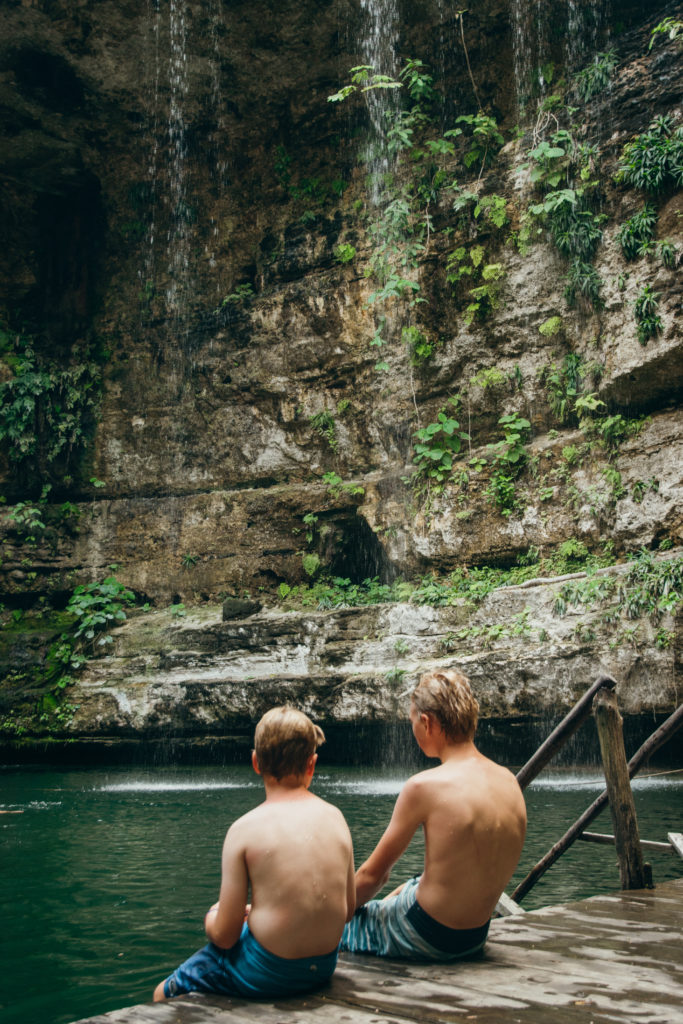
Cenote Saamal, located in the Hacienda Selva Maya, is another lesser visited cenote that makes for a popular stop for people visiting the ruins of Chichen Itza and Balam. It is a stunning cenote that is open with a manmade waterfall cascading into it. Above the cenote you will find a stream of water that feeds a manmade waterfall, inviting you to relax and feel refreshed in a uniquely peaceful and beautiful environment. Life jackets are required here and included in your admission.
Cost: 80 pesos ($4 USD)
Hours: 9AM-5PM
There are a few helpful tips to know when visiting almost every cenote in Mexico.
1. Do not wear or bring sunscreen. To keep the water in the cenotes pristine, most places ask you that you refrain from putting sunscreen on your body before entering the cenote. To combat a sunburn, opt to wear a protective SPF shirt or rashguard instead.
2. Never leave your valuables in the car. This might go without saying, but there have been several reported incidents of theft from cars in the parking lots of cenotes (tourists can be a target), so make sure to keep valuables back at your hotel, locked in the trunk, or with you at all times.
3. Pack a lunch and bring water with you if you plan to spend a fair amount of time at the cenotes. Some of the cenotes have on-site restaurants, but most do not.
4. Other items to bring: water shoes, snorkeling gear (unless you plan to rent), towels, and extra cash. Some cenotes offer life jacket rentals too if you need life jackets for little ones or non-swimmers.
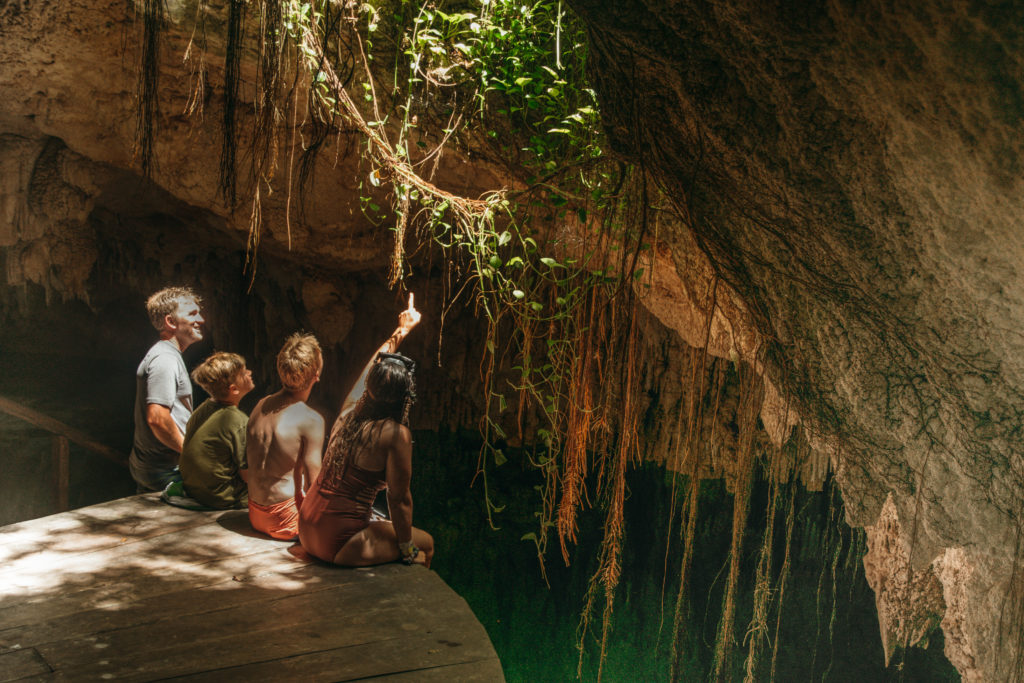
If you are looking for other suggestions on things to do on the Yucatan with kids, make sure to check out our post on the 12 Best Family Outdoor Activities Near Tulum, as well as our 10 Day Epic Yucatan Road Trip.